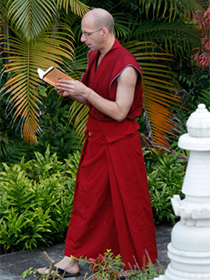- Home
- FPMT Homepage
Foundation for the Preservation of the Mahayana Tradition
The FPMT is an organization devoted to preserving and spreading Mahayana Buddhism worldwide by creating opportunities to listen, reflect, meditate, practice and actualize the unmistaken teachings of the Buddha and based on that experience spreading the Dharma to sentient beings. We provide integrated education through which people’s minds and hearts can be transformed into their highest potential for the benefit of others, inspired by an attitude of universal responsibility and service. We are committed to creating harmonious environments and helping all beings develop their full potential of infinite wisdom and compassion. Our organization is based on the Buddhist tradition of Lama Tsongkhapa of Tibet as taught to us by our founders Lama Thubten Yeshe and Lama Thubten Zopa Rinpoche.
- Willkommen
Die Stiftung zur Erhaltung der Mahayana Tradition (FPMT) ist eine Organisation, die sich weltweit für die Erhaltung und Verbreitung des Mahayana-Buddhismus einsetzt, indem sie Möglichkeiten schafft, den makellosen Lehren des Buddha zuzuhören, über sie zur reflektieren und zu meditieren und auf der Grundlage dieser Erfahrung das Dharma unter den Lebewesen zu verbreiten.
Wir bieten integrierte Schulungswege an, durch denen der Geist und das Herz der Menschen in ihr höchstes Potential verwandelt werden zum Wohl der anderen – inspiriert durch eine Haltung der universellen Verantwortung und dem Wunsch zu dienen. Wir haben uns verpflichtet, harmonische Umgebungen zu schaffen und allen Wesen zu helfen, ihr volles Potenzial unendlicher Weisheit und grenzenlosen Mitgefühls zu verwirklichen.
Unsere Organisation basiert auf der buddhistischen Tradition von Lama Tsongkhapa von Tibet, so wie sie uns von unseren Gründern Lama Thubten Yeshe und Lama Thubten Zopa Rinpoche gelehrt wird.
- Bienvenidos
La Fundación para la preservación de la tradición Mahayana (FPMT) es una organización que se dedica a preservar y difundir el budismo Mahayana en todo el mundo, creando oportunidades para escuchar, reflexionar, meditar, practicar y actualizar las enseñanzas inconfundibles de Buda y en base a esa experiencia difundir el Dharma a los seres.
Proporcionamos una educación integrada a través de la cual las mentes y los corazones de las personas se pueden transformar en su mayor potencial para el beneficio de los demás, inspirados por una actitud de responsabilidad y servicio universales. Estamos comprometidos a crear ambientes armoniosos y ayudar a todos los seres a desarrollar todo su potencial de infinita sabiduría y compasión.
Nuestra organización se basa en la tradición budista de Lama Tsongkhapa del Tíbet como nos lo enseñaron nuestros fundadores Lama Thubten Yeshe y Lama Zopa Rinpoche.
A continuación puede ver una lista de los centros y sus páginas web en su lengua preferida.
- Bienvenue
L’organisation de la FPMT a pour vocation la préservation et la diffusion du bouddhisme du mahayana dans le monde entier. Elle offre l’opportunité d’écouter, de réfléchir, de méditer, de pratiquer et de réaliser les enseignements excellents du Bouddha, pour ensuite transmettre le Dharma à tous les êtres. Nous proposons une formation intégrée grâce à laquelle le cœur et l’esprit de chacun peuvent accomplir leur potentiel le plus élevé pour le bien d’autrui, inspirés par le sens du service et une responsabilité universelle. Nous nous engageons à créer un environnement harmonieux et à aider tous les êtres à épanouir leur potentiel illimité de compassion et de sagesse. Notre organisation s’appuie sur la tradition guéloukpa de Lama Tsongkhapa du Tibet, telle qu’elle a été enseignée par nos fondateurs Lama Thoubtèn Yéshé et Lama Zopa Rinpoché.
Visitez le site de notre Editions Mahayana pour les traductions, conseils et nouvelles du Bureau international en français.
Voici une liste de centres et de leurs sites dans votre langue préférée
- Benvenuto
L’FPMT è un organizzazione il cui scopo è preservare e diffondere il Buddhismo Mahayana nel mondo, creando occasioni di ascolto, riflessione, meditazione e pratica dei perfetti insegnamenti del Buddha, al fine di attualizzare e diffondere il Dharma fra tutti gli esseri senzienti.
Offriamo un’educazione integrata, che può trasformare la mente e i cuori delle persone nel loro massimo potenziale, per il beneficio di tutti gli esseri, ispirati da un’attitudine di responsabilità universale e di servizio.
Il nostro obiettivo è quello di creare contesti armoniosi e aiutare tutti gli esseri a sviluppare in modo completo le proprie potenzialità di infinita saggezza e compassione.
La nostra organizzazione si basa sulla tradizione buddhista di Lama Tsongkhapa del Tibet, così come ci è stata insegnata dai nostri fondatori Lama Thubten Yeshe e Lama Zopa Rinpoche.
Di seguito potete trovare un elenco dei centri e dei loro siti nella lingua da voi prescelta.
- 欢迎 / 歡迎
简体中文
“护持大乘法脉基金会”( 英文简称:FPMT。全名:Foundation for the Preservation of the Mahayana Tradition) 是一个致力于护持和弘扬大乘佛法的国际佛教组织。我们提供听闻,思维,禅修,修行和实证佛陀无误教法的机会,以便让一切众生都能够享受佛法的指引和滋润。
我们全力创造和谐融洽的环境, 为人们提供解行并重的完整佛法教育,以便启发内在的环宇悲心及责任心,并开发内心所蕴藏的巨大潜能 — 无限的智慧与悲心 — 以便利益和服务一切有情。
FPMT的创办人是图腾耶喜喇嘛和喇嘛梭巴仁波切。我们所修习的是由两位上师所教导的,西藏喀巴大师的佛法传承。
繁體中文
護持大乘法脈基金會”( 英文簡稱:FPMT。全名:Found
ation for the Preservation of the Mahayana Tradition ) 是一個致力於護持和弘揚大乘佛法的國際佛教組織。我們提供聽聞, 思維,禪修,修行和實證佛陀無誤教法的機會,以便讓一切眾生都能 夠享受佛法的指引和滋潤。 我們全力創造和諧融洽的環境,
為人們提供解行並重的完整佛法教育,以便啟發內在的環宇悲心及責 任心,並開發內心所蘊藏的巨大潛能 — 無限的智慧與悲心 – – 以便利益和服務一切有情。 FPMT的創辦人是圖騰耶喜喇嘛和喇嘛梭巴仁波切。
我們所修習的是由兩位上師所教導的,西藏喀巴大師的佛法傳承。 察看道场信息:
- FPMT Homepage
- News/Media
-
- Study & Practice
-
-
- About FPMT Education Services
- Latest News
- Programs
- New to Buddhism?
- Buddhist Mind Science: Activating Your Potential
- Heart Advice for Death and Dying
- Discovering Buddhism
- Living in the Path
- Exploring Buddhism
- FPMT Basic Program
- FPMT Masters Program
- FPMT In-Depth Meditation Training
- Maitripa College
- Lotsawa Rinchen Zangpo Translator Program
- Universal Education for Compassion & Wisdom
- Online Learning Center
-
- Prayers & Practice Materials
- Overview of Prayers & Practices
- Full Catalogue of Prayers & Practice Materials
- Explore Popular Topics
- Benefiting Animals
- Chenrezig Resources
- Death & Dying Resources
- Lama Chopa (Guru Puja)
- Lama Zopa Rinpoche: Compendium of Precious Instructions
- Lama Zopa Rinpoche: Life Practice Advice
- Lama Zopa Rinpoche Practice Series
- Lamrim Resources
- Mantras
- Prayer Book Updates
- Purification Practices
- Sutras
- Thought Transformation (Lojong)
- Audio Materials
- Dharma Dates - Tibetan Calendar
- Translation Services
- Publishing Services
- Ways to Offer Support
- Prayers & Practice Materials
-
- Teachings and Advice
- Find Teachings and Advice
- Lama Zopa Rinpoche Advice Page
- Lama Zopa Rinpoche: Compendium of Precious Instructions
- Lama Zopa Rinpoche Video Teachings
- ༧སྐྱབས་རྗེ་བཟོད་པ་རིན་པོ་ཆེ་མཆོག་ནས་སྩལ་བའི་བཀའ་སློབ་བརྙན་འཕྲིན།
- Podcasts
- Lama Yeshe Wisdom Archive
- Buddhism FAQ
- Dharma for Young People
- Resources on Holy Objects
- Teachings and Advice
-
-
*If a menu item has a submenu clicking once will expand the menu clicking twice will open the page.
-
-
- Centers
-
- Teachers
-
- Projects
-
-
-
-
*If a menu item has a submenu clicking once will expand the menu clicking twice will open the page.
-
-
- FPMT
-
-
-
-
-
Dharma is a total way of life. It’s not just for breakfast, Sundays, or the temple. If you’re subdued and controlled in the temple but aggressive and uncontrolled outside of it, your understanding of Dharma is neither continuous nor indestructible.
Lama Yeshe
-
-
-
- Shop
-
-
-
The Foundation Store is FPMT’s online shop and features a vast selection of Buddhist study and practice materials written or recommended by our lineage gurus. These items include homestudy programs, prayers and practices in PDF or eBook format, materials for children, and other resources to support practitioners.
Items displayed in the shop are made available for Dharma practice and educational purposes, and never for the purpose of profiting from their sale. Please read FPMT Foundation Store Policy Regarding Dharma Items for more information.
-
-
Lama Zopa Rinpoche News and Advice
22
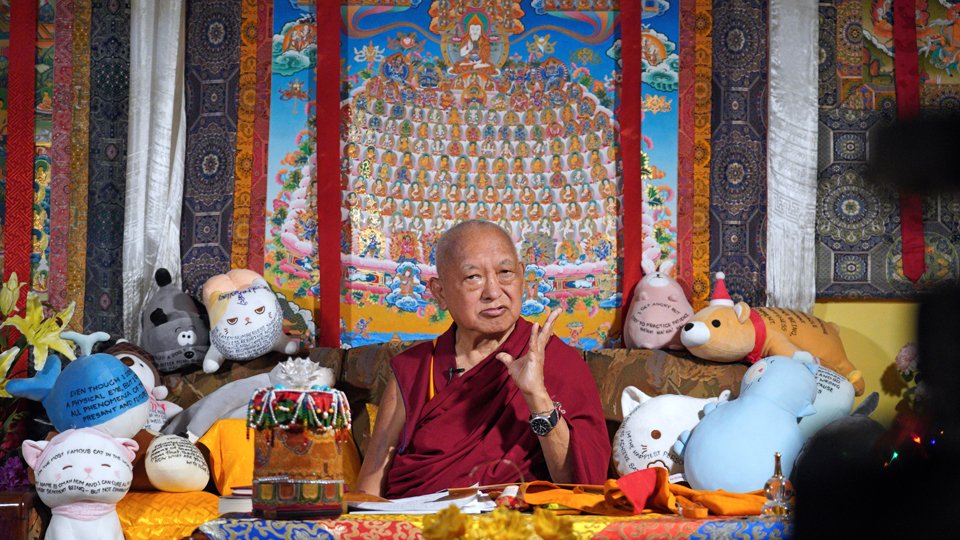
Lama Zopa Rinpoche doing his first video teaching for 2021, Kopan Monastery, Nepal, March 2021. Photo by Ven. Lobsang Sherab.
Lama Zopa Rinpoche continues his video teachings on thought transformation from Kopan Monastery in Nepal. Here is a summary of the most recent teaching:
Rinpoche begins this teaching extending his wishes that he hopes everyone had a nice long break from the teaching series (since December 16, 2020) and that we all are doing very well and using our time in a meaningful and beneficial way.
Rinpoche then extends those same wishes to every hell being, every hungry ghost, and every animal, including even the smallest insects and plankton. Rinpoche then reminds us that we have all been plankton numberless times in past lives. In fact, we have even been viruses numberless times! Rinpoche explains that since these tiny beings spread diseases such as COVID-19, we also have been those tiny beings numberless times, spreading diseases to others from beginningless rebirths. We have also been tigers and tiny biting insects numberless times, harming others, eating others, doing ugly actions, and creating fear.
It’s important to think about karma because it helps to recognize that life is not real, it’s more like a dream. If you think of the karma of being born as those beings in the lower realms, it is impossible to waste even a second of our precious human life distracted by attachment to pleasures of this life. Just like while you are dreaming, you believe everything is real when you are living your life. Only when you wake up, do you realize that everything is not as it appears. One day, when you are getting ready to die, you will realize that this life has been like a dream. Life happens, then is gone. We have to meditate on emptiness to recognize that life is a hallucination. Otherwise, we cheat ourselves every moment of every day by having a completely wrong concept. This is why it is so important to practice holy Dharma, so we don’t cheat ourselves. We have abused ourselves since beginningless rebirths.
Rinpoche then begins teaching us on what to do on the anniversary of our guru’s passing.
First, Rinpoche reminds us of the correct motivation for listening to the teachings, which is for happiness and not suffering. This is not for the temporary happiness of this life or even the happiness of liberation from samsara. The real purpose is to bring all the numberless sentient beings to Buddhahood—the total cessation of obscurations and completion of realizations. In order to do this, we must achieve omniscience. Without that, we can’t do perfect work for others without there being mistakes. We have to have perfect power to reveal the methods to gather sentient beings and complete compassion to embrace every sentient being in every realm. For this reason, we listen to the teachings, to achieve this.
Rinpoche then offers commentary on The Hundred Clear Realizations of the Glorious One from Narthang.
It is extremely meaningful to make offerings on the anniversary of your guru’s passing away, Rinpoche explains. You collect far greater merit by making offerings to the guru then you do by making offerings to all the three-time buddhas.
There are six benefits of making offerings on the anniversary of your guru’s passing away. The Hundred Clear Realizations of the Glorious One from Narthang offers the great Kadampa geshe Sharawa’s citation from Guhyasamaja and Vairochana’s Net of Magical Illusion:
- You complete your guru’s holy wishes.
- You purify the negative karmas and obscurations collected in dependence on the guru.
- You achieve extensive merits.
- In future lives, you meet gurus.
- You become an object to be subdued by gurus.
- You quickly cease your samsara.
Rinpoche offers commentary on each of these points and you can read this commentary in detail in the transcript of this teaching, starting at page 13.
When you make these offerings, you make them with the six remembrances:
- Remembering the aspect of the guru’s holy body when he was alive.
- Remembering that, first, after taking ordination, [your guru] was precise in the three higher trainings, and remember the qualities of the holy mind of [possessing] the transmitted teachings and direct realizations.
- Remembering the liberation stories of the divine teaching lineage of Great Jowo [Atisha], the Dharma tradition of great capable beings, which is not shared with other systems of the great charioteers.
- Remembering [the guru’s] kindness, thinking that all the perfections of samsara and beyond samsara, such as your own happiness, come from the guru.
- Remembering [the guru’s] blessing, thinking that everything you wish, such as being able to think of Dharma, is the blessing of the guru.
- Remembering to devote yourself [to the guru], imagining and bringing to mind that the guru and Buddha are not different.
Rinpoche offers commentary on each of these points, and we recommend following along in the transcript starting on page 17.
We invite you to go deeper into the topics presented here, plus many others, by watching Rinpoche’s video and reading the full transcript of Rinpoche’s teaching.
Watch Lama Zopa Rinpoche’s teaching “Make Offerings on the Anniversary of Your Guru’s Passing Away”:
https://youtu.be/Zh__457vmZs
-
- Read the transcript of Rinpoche’s teaching
- Find Rinpoche’s Teachings on Thought Transformation translated into Spanish, Italian, French, Chinese, and Russian
- Dedication verses for COVID-19 Crisis Teachings
Watch more from the video series Lama Zopa Rinpoche’s Teachings on Thought Transformation during the Time of COVID-19 and find links to videos in transcripts, MP3s, additional practice advice, and more:
https://fpmt.org/fpmt/announcements/resources-for-coronavirus-pandemic/advice-from-lama-zopa-rinpoche-for-coronavirus/
Practice advice from our teachers, Dharma study-from-home opportunities, and more can be found on the page “Resources for the Coronavirus Pandemic.”
Lama Zopa Rinpoche is the spiritual director of the Foundation for the Preservation of Mahayana Tradition (FPMT), a Tibetan Buddhist organization dedicated to the transmission of the Mahayana Buddhist tradition and values worldwide through teaching, meditation and community service.
- Tagged: advice from lama zopa rinpoche, coronavirus, guru devotion, lama zopa rinpoche thought transformation video teaching, the hundred clear realizations of the glorious one from narthang, video
16
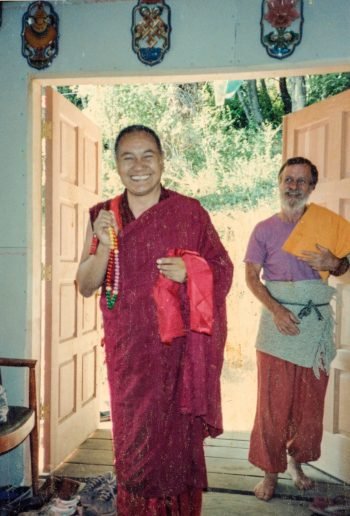
Lama Yeshe with Åge Delbanco, photo courtesy of Nicholas Ribush on Facebook
Lama Zopa Rinpoche requests for students who read obituaries belonging to members of our precious spiritual community, to please pray in the following manner: “May this person never ever be reborn in the lower realms and at the time of death be born in a pure land where they can be enlightened or to receive a perfect human body, meet the Mahayana teachings, and meet a perfectly qualified guru and by only pleasing the gurus mind, achieve enlightenment as quickly as possible.” Reading obituaries also helps us reflect upon our own death and rebirth and thus use our lives in the most meaningful way.
Åge Delbanco, who died on February 19, 2021, in California, US, was one of the earliest Western students of Lama Yeshe and Lama Zopa Rinpoche. Known by his nickname Babaji, he lived at Kopan in Nepal from 1970 to 1973. Even though Åge was from Denmark, California became his home. He became very involved at Vajarpani Institute a year after it started and lived there for thirteen years. He also served as an assistant to Lama Yeshe in 1983, when Lama Yeshe lived in the Santa Cruz-area for three months.
Åge died peacefully in his home in Santa Cruz at the age of 95, after a year of declining health. He had two close friends sitting with him as he passed, who provided him with Dharma support as he transitioned, reading prayers and practices from Lama Zopa Rinpoche’s book How to Face Death without Fear.
Lama Zopa Rinpoche sent a twenty-minute audio message after learning of Åge’s death. Here a short excerpt from Rinpoche’s message:
“So, please everybody pray for Babaji, who just passed away. Please everybody pray, especially the old students who knew him, thank you very, very much, and to not be reborn in lower realms. …
“Due to all the three time merits collected by oneself, three time merits collected by numberless sentient beings, numberless buddhas, may the Babaji be reborn in the pure land where he can be enlightened. Or, then he receives perfect human rebirth, meet Mahayana teachings, meet perfectly qualified Mahayana teacher, revealing the unmistaken path to enlightenment. And by pleasing most the holy mind of the Virtuous Friend, and then he achieve enlightenment as quick as possible.
“So please pray, at least like that. Thank you very much. Thank you very much. Babaji passing away is a teaching for us, teaching for us, reminding us of impermanence and death for ourself, and the need to make preparation for death, emphasizing to practice Dharma, without being lazy, and without the mind being distracted by attachment and anger.
“So yeah, to practice Dharma, to practice bodhichitta is the heart, and then, okay, thank you very much.”
Listen to the audio recording of Lama Zopa Rinpoche on the Death of Åge Delbanco:
An unedited transcript of the recording is available.
Rinpoche says this is the most critical time for a student, when we will all need the most help and support to avoid the lower realms and have a good rebirth. This is the time when students need to help each other. As soon as you hear of someone’s death, without hesitation, you can at least recite one mala of OM MANI PADME HUM. And then, according to one’s ability and availability, there are many other prayers and practices recommended for this purpose: https://fpmt.org/death/
Read a Mandala interview with Åge Delbanco from 2012.
Lama Zopa Rinpoche is the spiritual director of the Foundation for the Preservation of Mahayana Tradition (FPMT), a Tibetan Buddhist organization dedicated to the transmission of the Mahayana Buddhist tradition and values worldwide through teaching, meditation and community service.
12
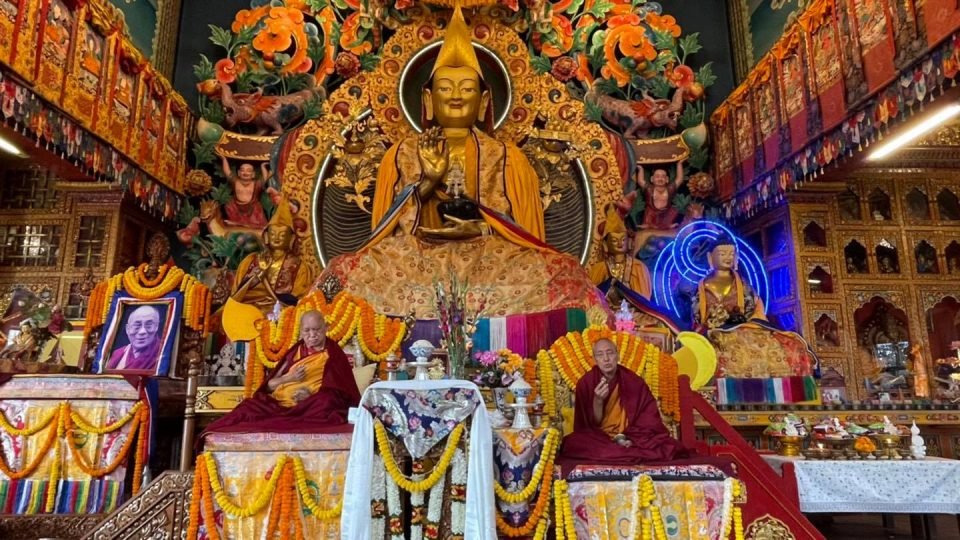
Lama Zopa Rinpoche and Khen Rinpoche Geshe Chonyi during the long life puja offered to both of them at Kopan Monastery, February 22, 2021.
Since mid-December, Lama Zopa Rinpoche has been taking a break from offering us his Thought Transformation during the Time of COVID-19 teaching series. Rinpoche is still in Nepal, at Kopan Monastery, and engaging in a variety of beneficial activities in the area. Below we share a few details of Rinpoche’s activities over the past couple of months.
A long life puja was offered to Lama Zopa Rinpoche and Khen Rinpoche Geshe Chonyi at Kopan Monastery on February 22, 2021. Rinpoche composed a long life prayer for Khen Rinpoche Geshe Chonyi, which was offered during the puja. One section of this prayer shared:
By revealing nakedly the excellent middle path free from extremes,
in which one realizes the reality of emptiness by realizing dependent-arising,
and realizes infallible cause and effect by realizing how things exist,
You are kind in freeing us from the ocean of suffering of beginningless cyclic existence.
O inconceivable virtuous spiritual friend,
May you live a long life and
May your wishes be spontaneously fulfilled!
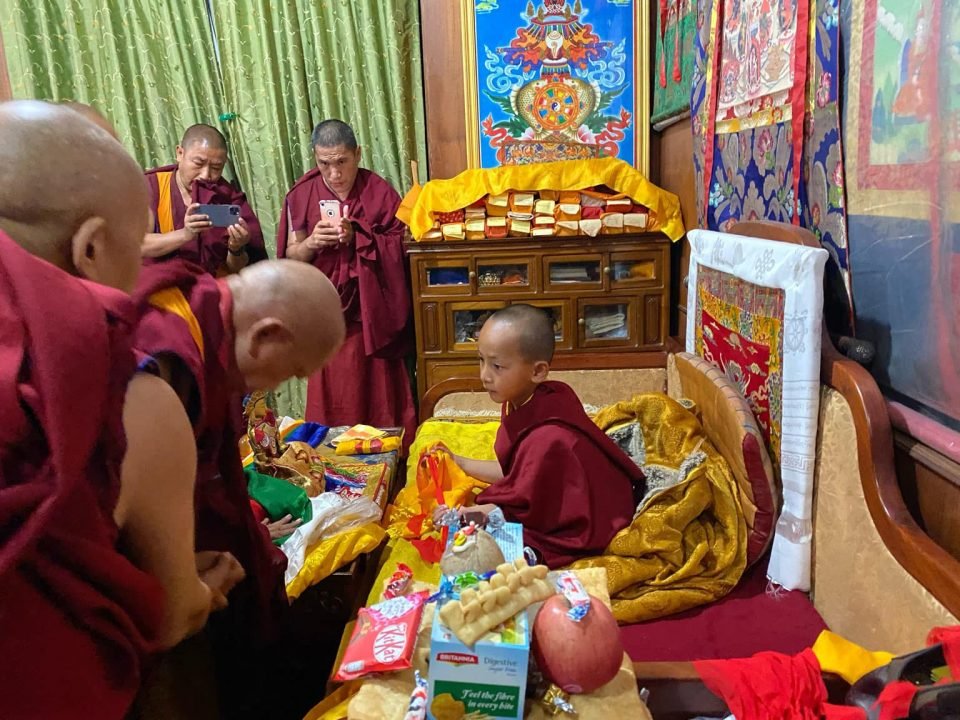
Lama Zopa Rinpoche meeting Trulshik Rinpoche, Nepal, February 20, 2021.
Rinpoche met the reincarnation of Trulshik Rinpoche on February 20 at his monastery in Swayambhunath. The previous Trulshik Rinpoche, who passed away in 2011, was one of Lama Zopa Rinpoche’s gurus.
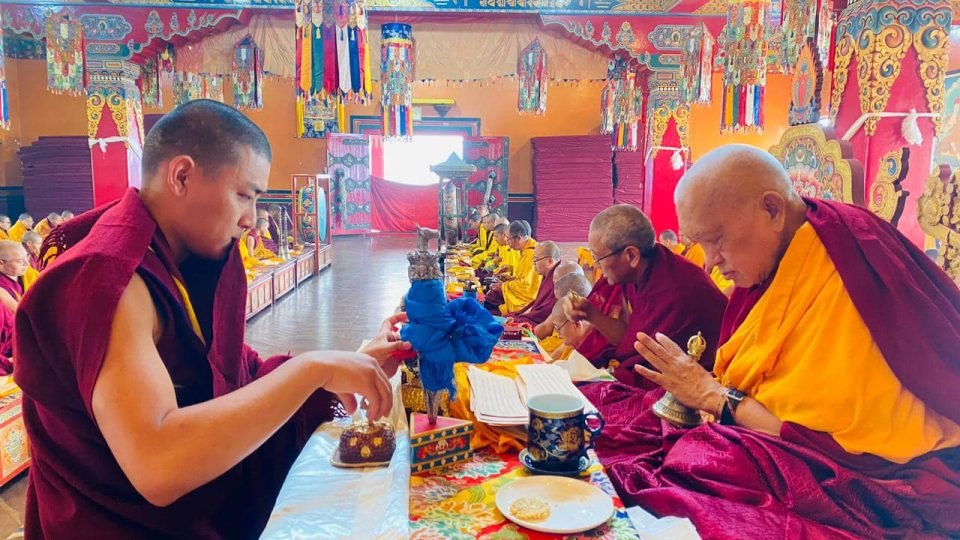
Lama Zopa Rinpoche, Khen Rinpoche Geshe Chonyi, and Kopan monks and nuns offering Most Secret Hayagriva Tsog Kong, February 13, 2021.
A Most Secret Hayagriva tsog kong puja to remove obstacles and benefit all beings was offered at Kopan Monastery on February 13 by Lama Zopa Rinpoche, Khen Rinpoche Geshe Chonyi, and Kopan monks and nuns. Several pujas of this type have offered for this purpose.
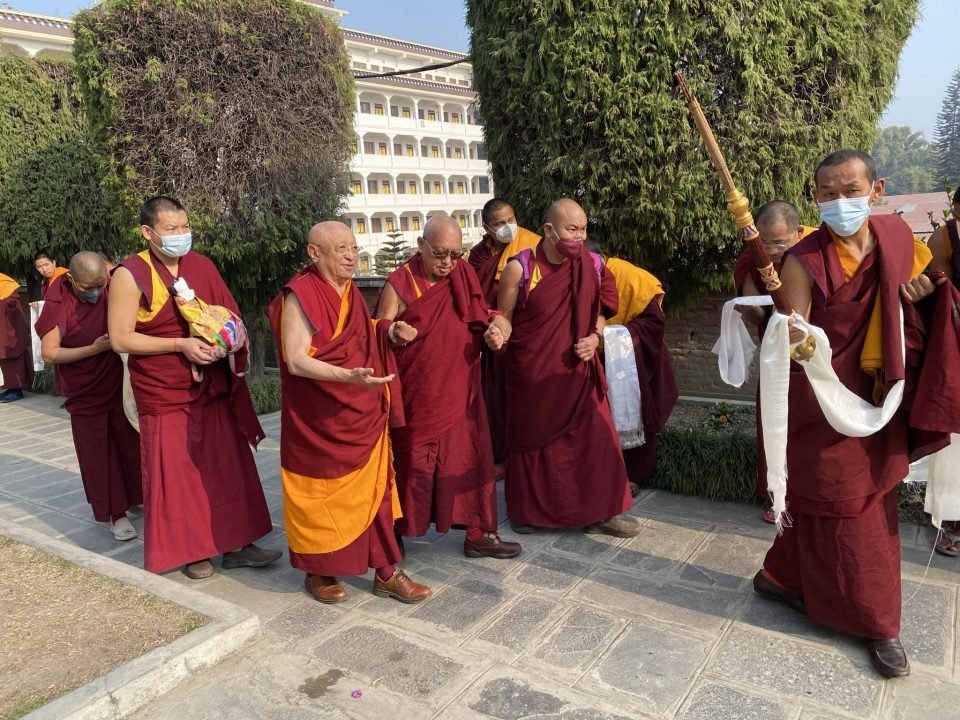
Lama Zopa Rinpoche walking with Chokyi Nyima Rinpoche, February 10, 2021. Photo by Lhundrup Topgye.
On February 10, Lama Zopa Rinpoche visited Ka-Nying Shedrup Ling Monastery in Kathmandu with Chokyi Nyima Rinpoche. Lama Zopa Rinpoche went to pay respects to the holy body of Chokling Rinpoche—who is Chokyi Nyima Rinpoche’s brother—and to offer an incense puja with Chokyi Nyima Rinpoche. There is beautiful and touching footage of this visit on Rinpoche’s Instagram.
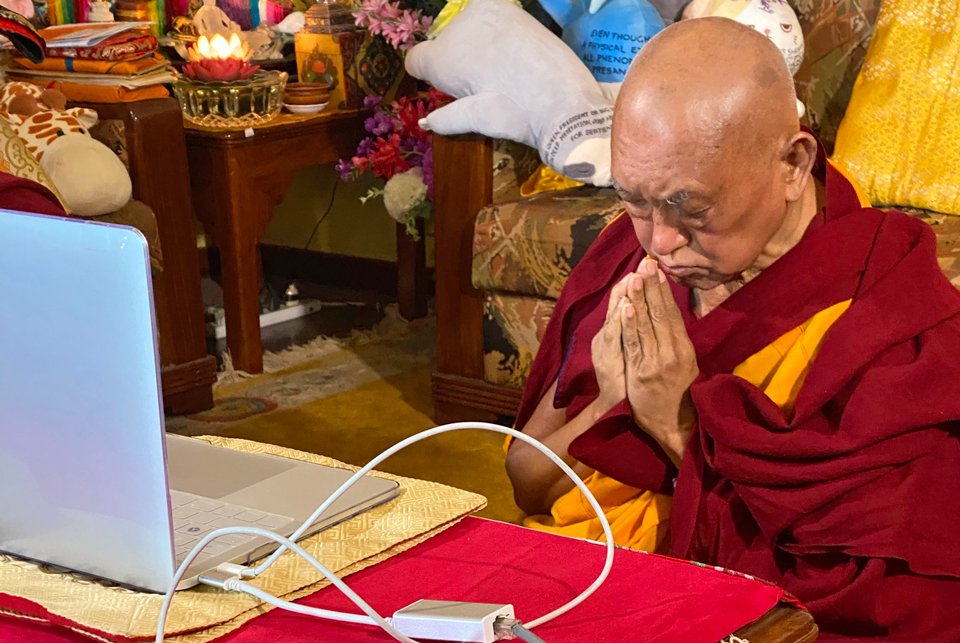
Lama Zopa Rinpoche during His Holiness the Dalai Lama’s teaching, Kopan Monastery, Nepal, February 8, 2021. Photo by Ven. Roger Kunsang.
His Holiness the Dalai Lama offered a teaching on Monday, February 8, 2021, at the request of Lama Zopa Rinpoche and the FPMT organization on Recognizing My Mother: An Experiential Song of the View (tagur ama ngodzin). The text, by the eighteenth-century Tibetan Buddhist master Changkya Rölpai Dorjé, is on dependent arising and emptiness. At the beginning and conclusion of the teaching, Lama Zopa Rinpoche read an introduction and dedication that he had composed for the teaching in Tibetan and made mandala offerings to His Holiness.
Rinpoche bought goats that were intended for slaughter and food on January 24 and blessed them before being released to their new home at the Animal Liberation Sanctuary. Rinpoche said, “Reciting prayers in their ears, verbally, to plant the seed of all the realizations of the path to enlightenment—this makes a huge difference. It has inconceivable result, unbelievable result.”
Please enjoy this video of Lama Zopa Rinpoche reciting mantras for these goats:
https://youtu.be/PNHl2LtBWx4
Rinpoche consecrated large appliqué Twenty-one Taras and Eight Taras That Save From Fear thangkas in the courtyard located outside the Kopan Monastery Gompa along with Khadro-la, Khen Rinpoche Geshe Chonyi, Kopan Lama Gyupas, and Kopan nuns on January 23. Rinpoche advised on every detail of these thangkas, and it took over a year for them to be made. They were offered to Rinpoche in a recent long life puja. After the consecration a special Tara puja was offered with Khadro la and the nuns.
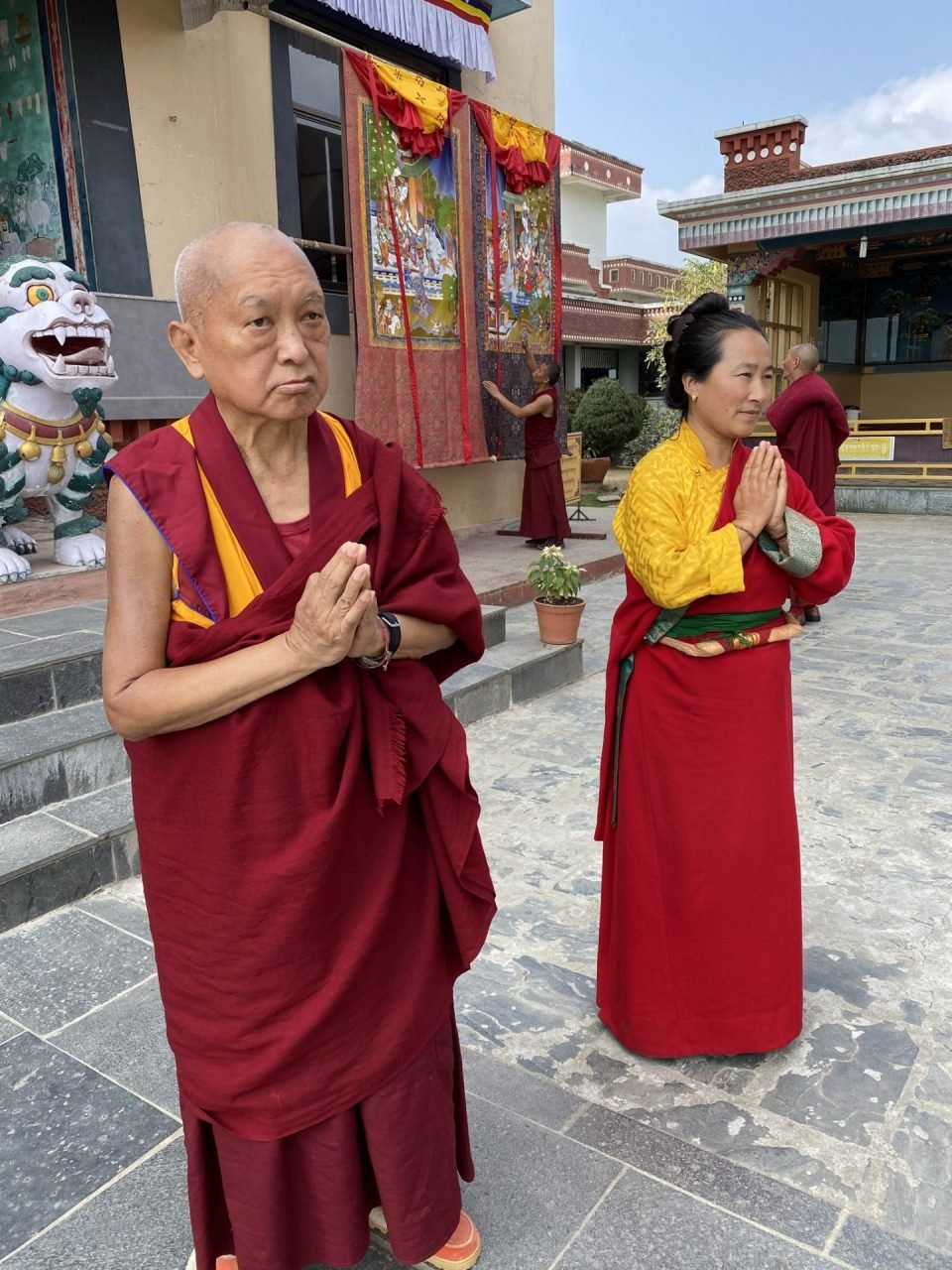
Lama Zopa Rinpoche and Khadro-la at the consecration of large appliqué Twenty-one Taras and Eight Taras That Save From Fear thangkas outside the Kopan Monastery Gompa. January 17, 2021, photo by Ven. Roger Kunsang.
Throughout this period Rinpoche has been giving lamrim teachings to the monks of Kopan Monastery and to the nuns of Kachoe Ghakyil Ling Nunnery.
These are just a few of the many auspicious activities Lama Zopa Rinpoche has been engaged in over the past couple of months at Kopan Monastery. We invite you to enjoy the new online galleries of photos, which show even more of Rinpoche’s recent activities, which we can all rejoice in:
- November and December 2020 photo gallery: fpmt.org/teachers/zopa/gallery/nepal-november-december-2020/
- January and February 2021 photo gallery: fpmt.org/teachers/zopa/gallery/nepal-january-february-2021/
Lama Zopa Rinpoche is the spiritual director of the Foundation for the Preservation of Mahayana Tradition (FPMT), a Tibetan Buddhist organization dedicated to the transmission of the Mahayana Buddhist tradition and values worldwide through teaching, meditation and community service.
Watch the video series Lama Zopa Rinpoche’s Teachings on Thought Transformation during the Time of COVID-19 and find links to videos in transcripts, MP3s, additional practice advice, and more:
https://fpmt.org/fpmt/announcements/resources-for-coronavirus-pandemic/advice-from-lama-zopa-rinpoche-for-coronavirus/
- Tagged: animal liberation, lama zopa rinpoche, lama zopa rinpoche activities, long life puja, trulshik rinpoche
10
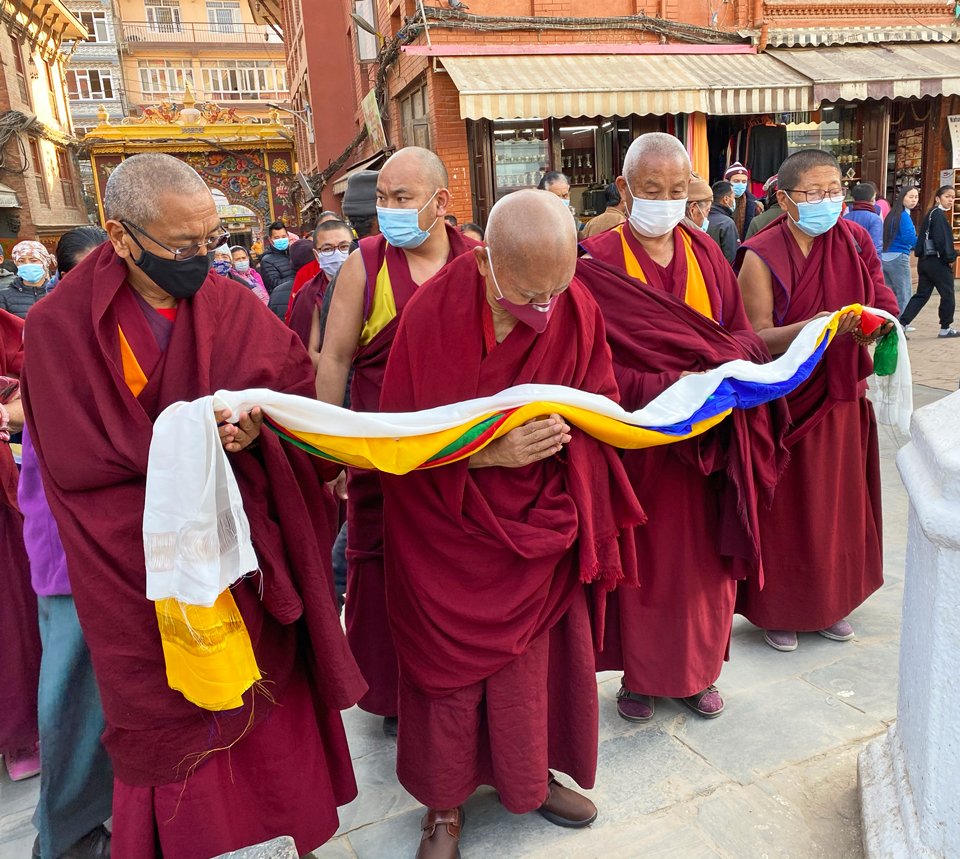
Khen Rinpoche Geshe Chonyi, Lama Zopa Rinpoche, Gen Tenpa Choden, and Ani Jangsem offering five-colored khata to the Boudha Stupa with prayers, Nepal, February 2021. Photo by Ven. Roger Kunsang.
In the following excerpt from Lama Zopa Rinpoche’s video teachings on thought transformation, Rinpoche explains that every single holy object is the basis for you to create all the merits that bring every success and pleasure that you experience now, as well causing your future liberation and enlightenment. All these holy objects came from every single sentient being, including the tiniest ant. Therefore, they are all sooooo precious, much more precious to us than millions of dollars. Whether a person is Buddhist or not, just seeing a holy object allows them to create soooo much merit.
If you put your hands together in prostration when you see a holy object, as well as offering lights and flowers rather than just thinking, “This is just a statue or painting,” you create even more merits than if you were to just see it.
Rinpoche explains that your motive for every daily activity should be only to benefit every living being and bring them to enlightenment. Getting up in the morning, dressing, eating breakfast, taking medicine, working, studying, meditating, and so forth, all should be done with the wish to benefit every single living being, including the tiniest insect.
Then you’ll have such a happy life, Rinpoche explains. You’ll have no regrets now, and when you die and in your future lives, you’ll achieve every success and realization, especially being able to benefit so many sentient beings. You should realize that you’re soooooo fortunate! This awareness will persuade you to create as much merit as possible.
Watch the eighteen minute video “Every Holy Object Comes from Every Sentient Being”:
https://youtu.be/sEqLVPQU7uA
Here is the transcript of Rinpoche’s teaching in this video:
Not Only Buddha, Dharma, and Sangha but Every Single Holy Object Comes from Every Sentient Being
Even the holy objects, not only Buddha, Dharma, and Sangha, but even every single holy object came from every insect, every human being. Not only every Buddha, Dharma, and Sangha came from them, but every statue, stupa, scripture—with which we create every single merit, the cause of happiness, the cause of enlightenment—came from them. We received [every single merit] from them, from every sentient being, every insect, every ant, every mosquito, every hell being, every hungry ghost, every animal, every human being, every sura being, every asura being, every sentient being. So they are the most precious.
Just by Seeing a Painting or Statue of a Buddha You Collect Numberless Greater Merits Than by Making Offerings to Solitary Realizer Arhats Equaling the Atoms of the Whole Entire Universe
[Sutra of the Mudra Developing the Power of Devotion says:འཇམ་དཔལ་རིགས་ཀྱི་བུའམ། རིགས་ཀྱི་བུ་མོ་གང་ལ་ལ་ཞིག་གིས་བསྐལ་པ་གངྒཱའི་ཀླུང་གི་བྱེ་མ་སྙེད་དུ་འཇིག་རྟེན་གྱི་ཁམས་ཐམས་ཅད་ཀྱི་རྡུལ་སྙེད་ཀྱི་རང་སངས་རྒྱས་དག་ལ་ཉིན་གཅིག་བཞིན་དུ་ལྷའི་ཟས་རོ་བརྒྱ་དང་ལྡན་པ་བྱིན་པ་དང་། དེ་བཞིན་དུ་ལྷའི་གོས་རྣམས་སྦྱིན་པ་བྱིན་པ་བས། འཇམ་དཔལ་རིགས་ཀྱི་བུའམ། རིགས་ཀྱི་བུ་མོ་གཞན་གང་ཞིག་གིས་སངས་རྒྱས་རི་མོར་བྲིས་པའམ། གཟུགས་སུ་བྱས་པ་མཐོང་ན། འདི་ནི་དེ་བས་བསོད་ནམས་ཆེས་གྲངས་མེད་པར་སྐྱེད་ན། ཐལ་མོ་སྦྱོར་བ་འམ། མེ་ཏོག་གམ། བདུག་པའམ། སྤོས་སམ། མར་མེ་འབུལ་བ་ལྟ་ཅི་སྨོས་ཏེ། འདི་ནི་དེ་བས་ཆེས་བསོད་ནམས་གྲངས་མེད་པར་སྐྱེད་ཏེ། ཞེས་གསུངས་སོ།
Jam päl rig kyi bu’am / rig kyi bu mo gang la la zhig gi käl pa gang gäi lung gi je ma nye du jig ten gyi kham tham chä kyi dül nye kyi rang sang gyä dag la nyin chig zhin du lhäi zä ro gya dang dän pa jin pa dang / de zhin du lhäi gö nam jin pa jin pa pä / jam päl rig kyi bu’am / rig kyi bu mo zhän gang zhig gi sang gyä ri mor dri pa’am / zug su jä pa thong na / di ni de wä so nam chhe drang me par kye na / thäl mo jor wa am / me tog gam / dug pa’am / pö sam / mar me bül wa ta chi mö te / di ni de wä chhe sö nam drang me par kye te / zhe sung so
Buddha said, “Manjushri, a boy or girl of the race, for eons equaling the sand grains of the River Ganga, offers divine food of a hundred tastes and, likewise, divine dress every day to solitary-realizer buddhas equaling the atoms of the whole entire universe, but, Manjushri, any other boy or girl of the race who sees a painting or statue of a buddha collects numberless greater merits. What need is there to mention that anyone who puts their palms together or offers flowers, scent, incense, or lights collects numberless greater merits than that?”]
So, there it says, if you see, just by seeing—it doesn’t matter whether you have devotion or non-devotion [or whether] you are a Buddhist or not—just by seeing a statue of Buddha or a painting of Buddha, just by that, just by seeing it, you create faaaaar more numberless, numberless greater merits, greater merits, but numberless, you create than the next one. You have to understand it well! [Than] for a hundred, for, I think, a hundred eons. I think that but I don’t [remember]. You get faint [when you understand for how many] eons. But for how many eons? According to the number of sand grains, the sand grains of the River Ganga, the Indian River Ganga. According to the number of… Eons, how many eons? According to the number of the sand grains of the River Ganga. I always forget that one.
By Putting Your Hands Together and Making Offerings to a Painting or Statue of a Buddha You Collect Numberless Greater Merits Than by Seeing It
Then it says, then it says, thäl mo jor wa am, “if you put the palms together like this or offer flowers or incense,” “scented smell or incense,” powder incense, stick incense, scented smell, incense stick, “or light….” Before I was telling [this to] the people who are offering water bowls here, so I was adding “water bowls.” It doesn’t mention water bowls but it is the same for everything. It can fit all the offerings. Before, I mentioned it before they left. I think before the last one left.[1] [If you offer] water bowls, no question, [you collect] even greater merit and numberless times than seeing a painting of Buddha, a picture, or a statue of Buddha. Di ni de wä chhe sö nam drang me par kye te / zhe sung so.
It is most incredible, most incredible, incredible. But many times we don’t know that, so, [we think] “Oh, that’s [just] a statute.” Even if you know it is a statue but you don’t do even this prostration, putting the palms together, you do nothing [due to thinking,] “Oh, that is [just] a statue or stupa.” You collect [so many merits] if you do like this. (Rinpoche shows putting the hands together in prostration.) So just by seeing you collect greater merits than before, all that, just by seeing a painting, picture, or statue. Oh, that is greater merits and numberless! Then, after that, if you do like this (Rinpoche shows putting the hands together in prostration) [you collect] even greater merits than before and numberless! For example, [if you prostrate to] Buddha.
All the Holy Objects Come from the Kindness of Every Single Insect, So They Are So Precious
So, all these holy objects that we see, we see numberless holy objects, statues, stupas, scriptures, they came from this mosquito, by the kindness of this mosquito, this ant, this tiny insect on humid wood. Whatever shape, [such] that it looks like a spider or whatever, [it came from] their kindness. It came from them. Wow, wow, wow. They are soooooo precious. Wow, wow, wow. They are sooooooooooooo precious, sooooooooooooo precious, sooooooooooooo precious. Now I ruin my voice. Now I ruin my voice. I have to save it.
It is incredible, if you know. So, their kindness, they are precious not by qualities as a buddha [is precious] but by their kindness. Aaaah. They are so, so, so precious. They are more precious than the Buddha, Dharma, and Sangha to whom we always pray, as I said before. We get liberated from the lower realms by remembering them (you don’t want to get reborn in the lower realms when you die) and you even get free from samsara and even get free from the lower nirvana, so you get enlightenment, free from suffering and obscurations. So, it all came from every sentient being, every insect. So, they are so precious. Lama khyen, lama khyen.
The Happiness That Comes from Money is Nothing Compared to the Happiness that Comes from Sentient Beings
Why do you think money is so precious, everybody spends the life, in the world people who don’t know, who doesn’t practice pure Dharma, they use their body, speech, and mind, even if human life is so precious, they use their whole life to make money, then they die. They suffer for money.
Now I’m forgetting what I’m saying.
So now I’m using the example of money. Because if we have money we can buy whatever we want, so everybody is working for money for that. But that is nothing. That is nothing. Happiness came from, as I said before, from sentient beings. All your happiness from beginningless rebirths, now, and in the future, temporary and ultimate, liberation and enlightenment, totally, everything came from sentient beings.
Whatever Happiness You Offer Even to a Tiny Insect Is So Important and So Precious
I was telling the monks, so therefore—I’m not going to talk much, just only about emptiness—so I told them that offering service to them, even to a tiny insect, whatever they need you offer, even giving food to the ants, not only to big [animals] but to tiny [ones], whatever you can do to serve them, whatever happiness you can offer to save them from suffering, whatever you can do is sooooooooooooo important, important, important, so precious, so precious. For you, it is so precious. It is most precious for you, so precious, precious, precious. It is so, so important for you, so precious, wow, wow, wow, whoa, anything you can do.
Doing Every Activity in the Service of Other Sentient Beings Is So Important
So, that’s why the motivation is to benefit sentient beings. Then, you get up, get dressed, and eat breakfast to benefit sentient beings, for them to achieve enlightenment, to free them from samsara and achieve enlightenment. To work for them, to benefit them, you are eating breakfast. Then you are going to work with that motivation to benefit sentient beings, to achieve enlightenment for sentient beings so that you can do perfect work. So, for the sentient beings, you are doing your work. Then having lunch. Then you are going, for sentient beings you are going to sleep. For sentient beings, everything is for sentient beings. Even if you are studying, any subject, Dharma or whatever, meditation, everything is for sentient beings. Eating medicine [is for sentient beings].
It is so important. So, it is very important, the service. It becomes service to all sentient beings, to the numberless sentient beings, to every tiny, tiniest insect, to the tiniest ones in the water, the ocean, I don’t remember the name. So, it is like that. You see? It is so important. Whatever you do by changing the motivation [and doing it] for others, then it becomes so, so important. It becomes very important service. It is so important [when you are] doing it for others, as service for others. Even studying Dharma, reflecting, meditation, even eating, sleeping. Then, your life is so happy. Most happy your life is. You have no regret. Now when you die, you are very happy, so satisfied, so happy. And in the future, you are so happy. From life to life, you have great success in benefiting sentient beings, [you have] more realizations, and [you are of] greater benefit to sentient beings. Then your happiness increases life to life and you go towards enlightenment. Wow, wow, wow.
That is okay. Now, the talk.
The Benefits You Get from the Numberless Buddha, Dharma, Sangha, Statues, Stupas, and Scriptures Come from Every Single Sentient Being
So, what I’m saying is that the numberless Buddha, Dharma, Sangha, statues, stupas, and scriptures, which, as I just mentioned, are of so much benefit to you, wow, wow, wow, you receive by every single sentient being, every single insect, the numberless hell beings, hungry ghosts, so sentient beings. Sentient beings are the most precious, most kind, most dear, wish-fulfilling, your wish-fulfilling. [From them come] aaaaaaaaaaaall temporary and ultimate happiness, liberation, enlightenment.
[1] Lama Zopa Rinpoche is referring to several students who helped Ven. Tenzin Namdrol with the water bowls during the lockdown at Kopan Monastery but then left to return to their home countries.
You can find resources and links on the topic of holy objects on the FPMT Education page Holy Objects.
Watch more from the video series Lama Zopa Rinpoche’s Teachings on Thought Transformation during the Time of COVID-19 and find links to videos in transcripts, MP3s, additional practice advice, and more:
https://fpmt.org/fpmt/announcements/resources-for-coronavirus-pandemic/advice-from-lama-zopa-rinpoche-for-coronavirus/
Lama Zopa Rinpoche is the spiritual director of the Foundation for the Preservation of Mahayana Tradition (FPMT), a Tibetan Buddhist organization dedicated to the transmission of the Mahayana Buddhist tradition and values worldwide through teaching, meditation and community service.
- Tagged: advice from lama zopa rinpoche, essential extract, essential extract thought transformation teachings, holy objects, video
5

Lama Zopa Rinpoche during His Holiness the Dalai Lama’s teaching, Kopan Monastery, Nepal, February 8, 2021. Photo by Ven. Roger Kunsang.
His Holiness the Dalai Lama offered a teaching on February 8, 2021, at the request of Lama Zopa Rinpoche and the FPMT organization on Changkya Rölpai Dorjé’s Recognizing My Mother: An Experiential Song of the View (tagur ama ngodzin).
At the beginning and conclusion of the teaching, Lama Zopa Rinpoche read an introduction and dedication that he had composed for the teaching in Tibetan and made mandala offerings to His Holiness. The following is an English translation of Rinpoche’s introduction and dedication.
Introduction
The great compassion of all the ten-direction, three-time buddhas manifested in human form,
Chenrezig, Supreme Being, Compassionate-Eye-Looking One, the karmic deity of the Snow Land of Tibet,
The sole object of refuge of us transmigratory beings—human beings, devas, asuras, hell beings, pretas, and animals—every single one,
Your Eminence, the Nobel Peace Prize laureate for world peace and happiness,
The guide of devas and human beings, the refuge-savior, wish-granting jewel who is always extremely busy enacting holy activities,
Out of your great compassion, thank you for your kindness in granting us, the students of the Foundation for the Preservation of the Mahayana Tradition, the teaching of the holy Dharma of Recognizing My Mother: An Experiential Song of the View. For that, I, a humble disciple, Thubten Zopa, on behalf of the FPMT, wish to express the compassion of your incalculable kindness.
[A mandala offering is made.]
By the sound of the great drum of Dharma,
May you set suffering sentient beings free.
Please teach us the Dharma and live
For inconceivable tens of millions of eons.
Like Bodhisattva Always Crying One followed Cho Phag,
Without being distracted by all—our body, life, and possessions,
May we please our holy virtuous friend well
And never displease you even for a second.

Lama Zopa Rinpoche with Vens. Topgye and Tendar watching His Holiness the Dalai Lama’s teaching, Kopan Monastery, Nepal, February 8, 2021. Photo by Ven. Roger Kunsang.
Conclusion and Dedication
[A short thanksgiving mandala is offered.]
The wish-granting, wish-fulfilling jewel,
Source of every single benefit and happiness in this world,
The incomparably kind, supreme Tenzin Gyatso,
May your life be long and all your holy wishes be spontaneously fulfilled.
Today our refuge-savior, the omniscient one, has kindly granted us Recognizing My Mother: An Experiential Song of the View. Even if we FPMT students were to fill the whole sky with wish-granting jewels and offer them to you, our refuge-savior, the omniscient one, and even if we were to achieve full enlightenment, how could we ever repay your kindness? There is no way for us to ever repay it.
That in this world Buddhism is considered by scientists and scholars to be so precious and valuable, and that each year Tibetans are held in good regard by more and more people, as human beings who are sincere in nature with good thoughts to benefit others, is totally and solely due to your kindness, precious refuge-savior.
But I, an ignorant one, have explained this. If there are people who can’t accept it, then the Seventh Dalai Lama, Kelzang Gyatso, said:
“In the view of the mind stirred up by delusions and spirit possession,
Even though we feel it is right, it is like the dancing act of a crazy one.
However many multitudes of vices looked down upon by the holy beings have been done,
From the depths of the heart, confess them individually with fervent regret.”
It is like that, but the difference is that, in the view of the mind stirred up by delusion or by spirit possession, feeling that the Pure One is bad is like the dancing act of a crazy one. Whatever collection of vices have been done that are looked down upon by the holy beings, from the heart, with strong regretfulness, individually confess them.
In the Madhyamika philosophy: “A container full of that which is wet and moist appears as water to human beings. But for those of greater fortune, the devas, it appears as nectar, while for those who lack merit, the pretas, it appears as pus and blood. It is helpful to think in that way.”
The Seventh Dalai Lama also said:
“The old mother sentient beings who have guided us with kindness again and again
Have fallen into the midst of a blazing fire of suffering.
Since we don’t have the ability to save them now,
Please bless us to quickly achieve enlightenment.”
Precious refuge-savior, whatever holy actions you do with your body, speech, and mind, even breathing in and out, they are all only a method for us transmigratory beings to quickly achieve the state of buddhahood.
The sublime, precious refuge-savior is like the eye looking at and the heart inside the body of this southern world and, in particular, the Snow Land of Tibet. Please remain until our samsara ends.
In the past Your Holiness visited many FPMT centers and granted us your holy teachings, guiding us with great compassion. We thank you for your peerless kindness.
I one-pointedly request that you continue to guide Tibetans in general and the students of the Foundation for the Preservation of the Mahayana Tradition in all our lives, without separation.

Screenshot of Lama Zopa Rinpoche with Vens. Topgye and Tendar. Rinpoche is listening to His Holiness the Dalai Lama talk to him, February 8, 2021
His Holiness’s Response
After the dedication, His Holiness declared, “Zopa Rinpoche and I have known each other a long time. We are trusted friends. You and your teacher Lama Thubten Yeshe founded many centers around the world to help others. Rinpoche, you have done your best, thank you. Please be determined to keep up your efforts. What you have achieved cannot be overlooked. Thank you and Tashi Delek.”
Watch the teaching and find links to resources
Students can watch a recording of His Holiness the Dalai Lama’s teaching “Recognizing My Mother: An Experiential Song on the View” on DalaiLama.com.
Download the PDF of the English translation of Changkya Rölpai Dorjé’s Recognizing My Mother: An Experiential Song of the View (tagur ama ngodzin).
You can read a detailed summary of His Holiness’s teaching and question and answer session on DalaiLama.com.
Find explanatory notes of Recognizing My Mother: An Experiential Song of the View by Geshe Kelsang Wongmo on the FPMT “Prayers and Practices Free Downloads” page.
For more live teachings and video recordings of His Holiness the Dalai Lama, visit DalaiLama.com.
Read our earlier story on this event: “FPMT Community Rejoices for Teaching with His Holiness the Dalai Lama.”
Currently, Lama Zopa Rinpoche is taking a break from offering his video series Teachings on Thought Transformation during the Time of COVID-19. Find links to the ninety published videos in this series as well as transcripts, MP3s, additional practice advice, and more:
https://fpmt.org/fpmt/announcements/resources-for-coronavirus-pandemic/advice-from-lama-zopa-rinpoche-for-coronavirus/
FPMT.org and Mandala Publications brings you news of Lama Zopa Rinpoche and of activities, teachings, and events from over 160 FPMT centers, projects, and services around the globe. If you like what you read, consider becoming a Friend of FPMT, which supports our work.
2
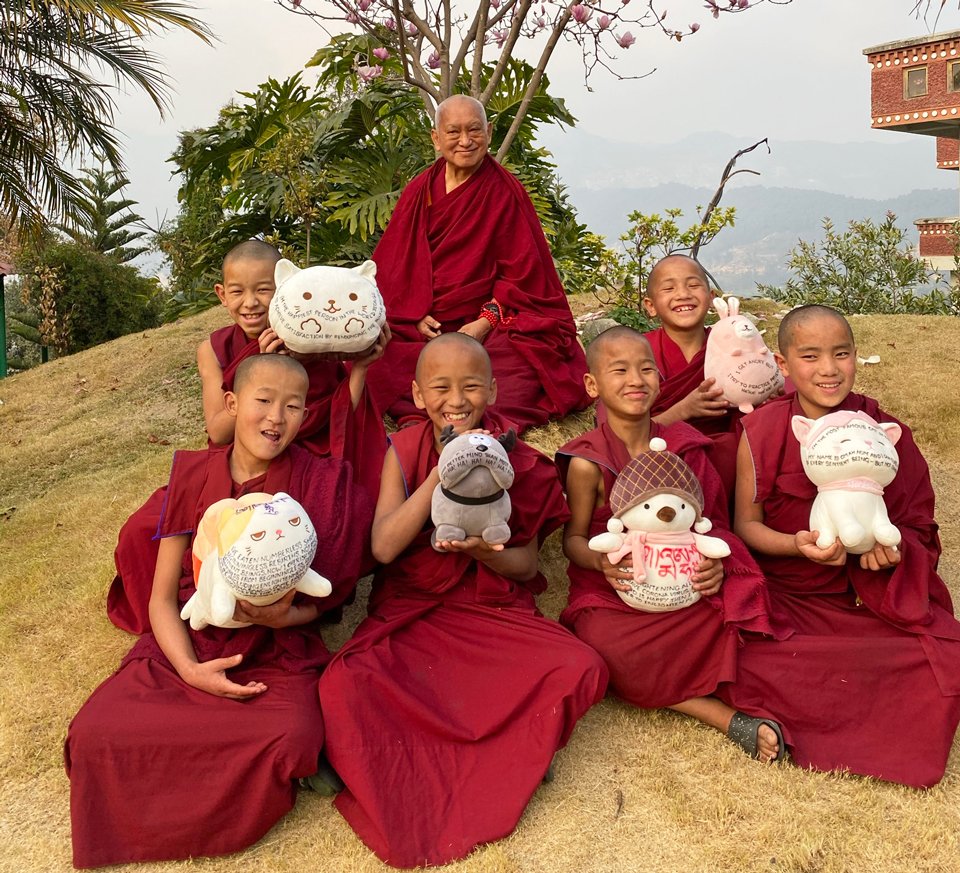
Lama Zopa Rinpoche with young monks and stuffed”friends” with Dharma messages written upon them, Kopan Monastery, February 2021. Photo by Ven. Roger Kunsang.
In an introductory talk at the first Light of the Path retreat in 2009, Lama Zopa Rinpoche explains why everything—good and bad—depends on our mental attitude and why having a good heart wishing to benefit all living beings is so essential. This teachings, which includes stories from Rinpoche’s own early life, is available as the multimedia teaching Everything Depends on Your Attitude. Here is a short excerpt from it:
Our Lives Have Been Most Fortunate
It seems that many old minds have come back to attend this Dharma course, and however our lives have been up to now, that is extremely worthwhile.
I would say that compared to others, our lives have been most fortunate. First of all, many of us have heard the heart of the Buddhadharma, the very essence of the 84,000 teachings of the Buddha, the very precious teaching on the stages of the path to enlightenment (lamrim) many times. We have even heard this from His Holiness the Dalai Lama himself, who is the real living Chenrezig, the Compassion Buddha manifested in the human form of a monk—the aspect that can most perfectly guide us. Just that alone is most amazing and inexpressible. It is the most unbelievable, rare, fortunate, and precious thing that could have happened to us this life.
Then we have met many other great teachers and unbelievably qualified virtuous friends who preserve the whole entire Buddhadharma—the Lesser Vehicle, Mahayana Paramitayana, and Mahayana Tantrayana teachings. Particularly, many of us older students have met and received teachings and initiations from Lama Yeshe, who was kinder than all the numberless past, present, and future buddhas, and whose holy name is extremely rare and difficult to express.
So really, if we look at what has happened to us so far in this life, it is most amazing to have met so many qualified virtuous friends who can reveal the complete path to enlightenment from their own experience. Can you imagine how most unbelievably fortunate our lives have been?
We Can’t Really Tell When Death Will Come
But of course, this incredible opportunity will not last long. It is just like lightning on a very dark night that for a short time reveals everything clearly and is then gone.
Life is not long and we can’t really tell when death will come. There are many conditions for death, like the 400 different types of disease, 360 spirit possessions, 1080 interferers, and these days there are new diseases that were never heard of before like swine flu. (There is no kangaroo flu yet — only pig flu!) Then there is cancer. We hear all the time about this and that friend or family member suddenly getting cancer. Up to now we have been hearing about our family members, friends, students, and others having cancer, but how can you tell that sooner or later other people won’t hear your own name with the word “cancer” next to it and a “has” in between? This happens to many people in the world. Already many older students we have known, who had been studying Dharma for some time, have passed away in different countries. We can never tell. We might be next. That is how life is.
Then there are many other sicknesses. For example, I have diabetes and that brings many symptoms. Sometimes I have been a friend of diabetes and sometimes an enemy. We cannot always live our lives with the concept of permanence, thinking “I am going to live forever.” Well, maybe not “forever”—unless you are on drugs or hallucinating! But anyway, life is very short, and there is not much time left.
Generally, life is very short in degenerate times and even things that are supposed to support life can become the conditions for death. For example, medicines can have side effects leading to death and many people die when their houses collapse or while eating food. …
Rinpoche continues this teaching discussing his experience at the refugee camp Buxa Duar, the early Western supporters and practitioners of Tibetan Buddhism he met in India, the importance of lamrim study and practice, and how we must cultivate the bodhichitta motivation.
Experience Lama Zopa Rinpoche’s entire teaching Everything Depends on Your Attitude in a multimedia format that weaves together video, audio, transcripts, and photos on the topic of one’s motivation, edited by Venerable Sarah Thresher with Megan Evart for the Lama Yeshe Wisdom Archive:
http://multimedia.lamayeshe.com/everything-depends-on-your-attitude
There are more than twenty multimedia presentations from the Lama Yeshe Wisdom Archive for students at any level to explore and deepen their understanding of the teachings of Buddha as shared by Lama Yeshe and Lama Zopa Rinpoche.
Currently, Lama Zopa Rinpoche is taking a break from offering his video series Teachings on Thought Transformation during the Time of COVID-19. Find links to the ninety published videos in this series as well as transcripts, MP3s, additional practice advice, and more:
https://fpmt.org/fpmt/announcements/resources-for-coronavirus-pandemic/advice-from-lama-zopa-rinpoche-for-coronavirus/
Lama Zopa Rinpoche is the spiritual director of the Foundation for the Preservation of Mahayana Tradition (FPMT), a Tibetan Buddhist organization dedicated to the transmission of the Mahayana Buddhist tradition and values worldwide through teaching, meditation and community service.
24
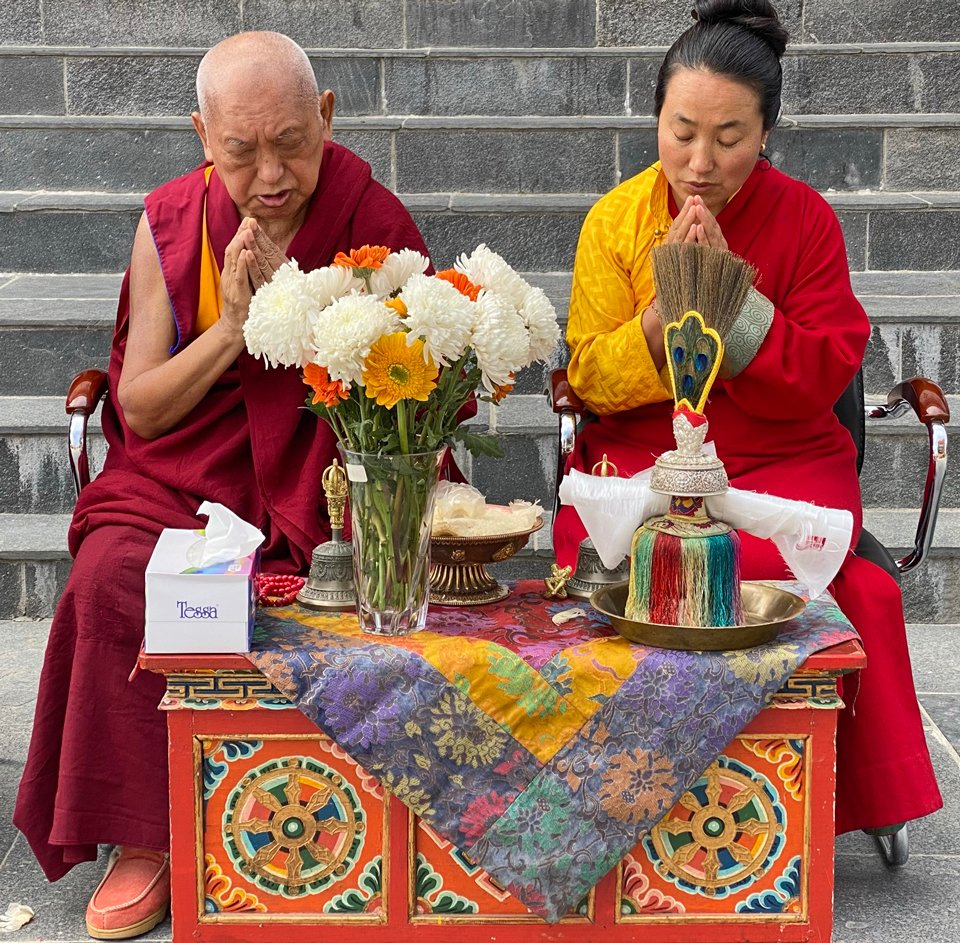
Lama Zopa Rinpoche and Khadro-la during the consecration of large appliqué thangkas of the Twenty-One Taras and the Eight Taras That Save From Fear in the courtyard outside of the main gompa at Kopan Monastery, Nepal, January 2021. Photo by Ven. Roger Kunsang.
The Six Perfections: The Practice of the Bodhisattvas is a recent book from Lama Zopa Rinpoche, in which Rinpoche walks us through this key Mahayana Buddhist teaching. Here’s an excerpt from Rinpoche’s teaching on the perfection of charity:
Keeping our mind pure—free from pride, miserliness, and so forth—is very difficult for ordinary people like us. If we could give simply, without all these disturbing thoughts clouding our giving, our generosity would be perfect and attaining another perfect human rebirth would be easy. But this is a struggle for most of us. That is why we must always check our motivation and be diligent in observing our karma.
The villagers of Solu Khumbu, where I was born, have a very good custom to protect themselves and others. Because they are incredibly poor, theft is always a problem. Things are often stolen: cooking pots, money—even potatoes. In many villages the people bury pots of their precious potatoes outside to keep them safe, but thieves can generally guess where the pots are buried, and they dig them up. Also, sometimes people borrow things and don’t return them, no matter how much the owner complains and shouts.
In such cases of theft, the villagers often go to a monastery and ask the lama there to say prayers and dedicate the merit of the prayer to the thief, totally offering them that thing. Whether or not this becomes a virtuous act does not depend on the lama but on the mind of the victim. If the person can renounce the stolen object completely and offer it to the thief with compassion, then it is virtuous. The owner needs the object, but the thief also needs it, and so by renouncing it and offering it to the thief with compassion, the dedication becomes a virtuous action.
If somebody stole a hundred dollars from us and we cannot do the practice of dedication—if we cannot take the loss upon ourselves and offer the victory to that sentient being; if we still cling to that hundred dollars—how can we perfect the practice of charity? Even without considering how kind that sentient being has been, how precious they are, we should rejoice that they needed something and now they have it. Like us, they want happiness and do not want suffering—in that way they are completely equal to us—so why can’t they have that hundred dollars? If we were to find a hundred dollars, how happy we would be. If we were to find a thousand dollars or a million dollars, we would be so surprised and excited. We would clap our hands with joy. So why can’t we do the same thing for this sentient being who has come across a hundred dollars?
Learn more about The Six Perfections: The Practice of the Bodhisattvas, including order information, on Wisdom Publication’s website or order from the FPMT Foundation Store.
During February 2021, Lama Zopa Rinpoche is taking a break from offering his video series Teachings on Thought Transformation during the Time of COVID-19. Find links to the ninety published videos in this series as well as transcripts, MP3s, additional practice advice, and more:
https://fpmt.org/fpmt/announcements/resources-for-coronavirus-pandemic/advice-from-lama-zopa-rinpoche-for-coronavirus/
Lama Zopa Rinpoche is the spiritual director of the Foundation for the Preservation of Mahayana Tradition (FPMT), a Tibetan Buddhist organization dedicated to the transmission of the Mahayana Buddhist tradition and values worldwide through teaching, meditation and community service.
18
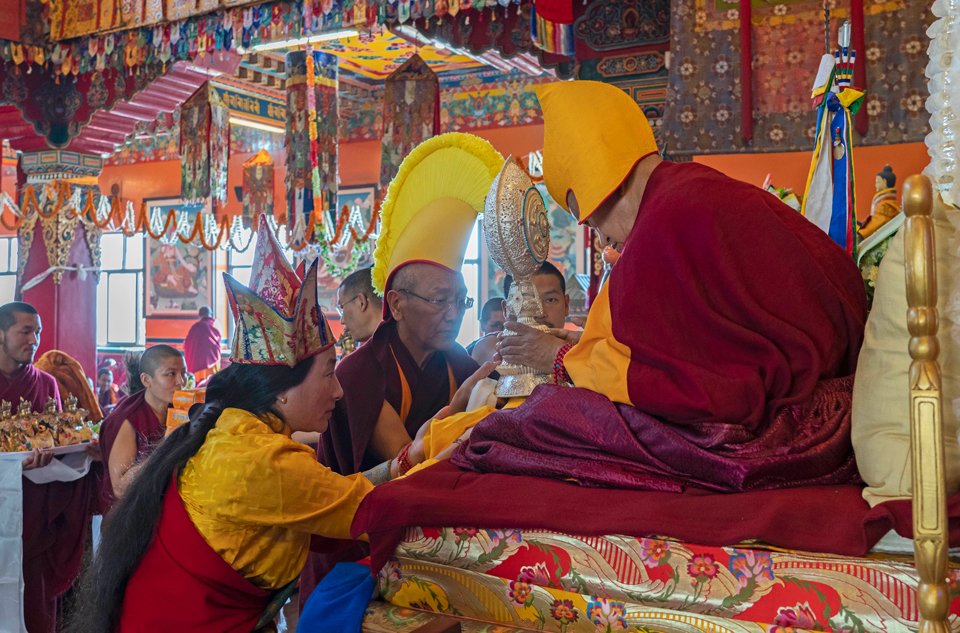
Khadro-la and Khen Rinpoche Geshe Chonyi offering a dharmachakra to Lama Zopa Rinpoche, during a long life puja for Rinpoche, Kopan Monastery, December 2020. Photo by Ven. Lobsang Sherab.
In the following half-hour Essential Extract video, from a teaching Lama Zopa Rinpoche gave in December 2019 at Kopan Monastery, Rinpoche explains the difference between the appearance of our body as a base to be labeled “I,” the label itself, and the mistaken view that this I exists from its own side and that we are the aggregates. He compares this with mistaking a rope at dusk for a snake. Rinpoche emphasizes that everything is empty, but that this does not mean nothing exists. We have to bring the two truths together. For example, when we get angry, we can apply this meditation to realize that the “real I” that gets angry does not truly exist. Then the anger is gone immediately. The same goes for attachment and all delusions. And even birth and death do not exist from their own side. We think we have a “real” son or “real” daughter or “real” wealth. That is impossible, Rinpoche teaches, as there is not even a “real I.”
Watch the video “The ‘Real I’ That Gets Angry Does Not Exist”:
https://youtu.be/Bn7eHOeVU_s
Transcript: Then using the example, the body and mind in your view, the way you think, the way you believe your body and mind is like a piece of rope on the road curled like a snake, different colors and curled. Nang sel … means the way it appears to you, the body and mind are like a piece of rope, a piece of different colored rope curled. That is the appearance, then believing, then you label, because of the way it is curled and the different colors, you see, somebody who doesn’t have clear eyes, shimmering, evening time after sunset, thinks, “Oh, there is a snake.” By labeling “snake” and believing your label, snake, you get frightened. But there is no snake from the tip of the hairs, down to … The piece of the rope, every hair you look at, there is no snake there, but you label [“snake”] because in the evening time, at dusk time, the different colors and the way it is curled, it appears as a snake and then you get fear, terror.
So like that this body and mind are not I. They are not I at all. I told you yesterday or the day before yesterday. You remember I told you? But you label “I” on that and believe that is I, like you label “snake” and the fear comes, like that. It is not I, it is the base to be labeled but not the I.
You remember I mentioned M? There is the base to be labeled “M” and “M” is what is to be labeled. Tag zhi is the base to labeled, and “M” is what is labeled. They are not separate but [they are] two different things. Remember I told you the I and aggregates are two different things but not separate? You must know that, otherwise, you get caught in a hallucination, a wrong concept. You believe the body and mind are I, then all the worry-fear, everything. From that hallucination, wrong concept, hallucination, the ignorance, then all the fear, all the wrong, means all the fear comes.
Then, (Tibetan) then, “you call, you believe that is I, then suffering of pain, suffering of change, pervasive compounding suffering of samsara,” all the sufferings of samsara come in these three, you experience all that suffering. From beginningless rebirths up to now we have been suffering. [That] who made you suffer is the wrong concept, ignorance, believing your body and mind are I. You understand? You should know that. Due to that wrong concept you have suffered from beginningless rebirths. Then again if you don’t realize emptiness in this life, you will suffer again without end. Your wrong concept, ignorance, makes you suffer like by labeling “snake” on a piece of curled rope, then you get all the fear. But the snake you can’t find, it is not there. Like that, the hallucination. That is a very good meditation.
So the different examples how to meditate, there are many. There are many but some I don’t know. I received so many teachings, but due to laziness I didn’t study. I just give you some to meditate on. You understand? The easy ones. Then, that is your wrong concept, ignorance, that makes the suffering of three types—suffering of pain, suffering of change, pervasive compounding suffering—from beginningless rebirth, then again if you don’t realize emptiness, study emptiness, realize emptiness, two truths, [there is that] danger. Therefore, you need to study. You need to meditate. …
Read the complete transcript for this video extract.
Watch more videos from Lama Zopa Rinpoche’s teaching from the 2019 Kopan Course, the annual month-long lamrim course at Kopan Monastery in Nepal:
https://fpmt.org/media/streaming/teachings-of-lama-zopa-rinpoche/kopan-2019/
Find more Lama Zopa Rinpoche Essential Extracts videos:
https://fpmt.org/media/streaming/essential-extracts/
During February 2021, Rinpoche is taking a break from offering his video series Teachings on Thought Transformation during the Time of COVID-19. Find links to the ninety published videos in this series as well as transcripts, MP3s, additional practice advice, and more:
https://fpmt.org/fpmt/announcements/resources-for-coronavirus-pandemic/advice-from-lama-zopa-rinpoche-for-coronavirus/
Lama Zopa Rinpoche is the spiritual director of the Foundation for the Preservation of Mahayana Tradition (FPMT), a Tibetan Buddhist organization dedicated to the transmission of the Mahayana Buddhist tradition and values worldwide through teaching, meditation and community service.
- Tagged: emptiness, essential extract, lama zopa rinpoche, video
12
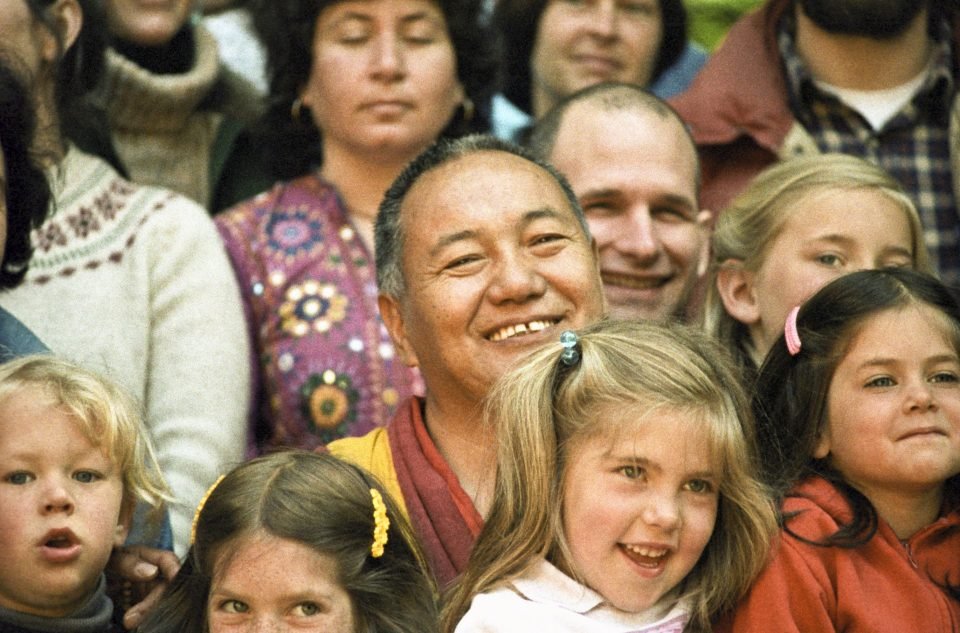
Lama Yeshe during a family gathering at Vajrapani Institute, California, US, 1983. Photo by Carol Royce, courtesy of Lama Yeshe Wisdom Archive.
The Tibetan New Year, Losar, falls on February 12 this year. For FPMT students, this day has additional significance as it commemorates the anniversary of the parinirvana of Lama Thubten Yeshe, who co-founded FPMT with Lama Zopa Rinpoche.
Lama Yeshe’s heart stopped beating just before dawn on Losar, March 3, 1984. He was forty-nine years old. In 1959, Lama Yeshe fled the Chinese Communists in Tibet, going into exile in India. He survived tremendous hardship living as a refugee monk in Buxa Duar, where Lama Zopa Rinpoche became his heart disciple. In 1967, the two lamas began teaching Western students, leading to the establishment and flourishing of Kopan Monastery in Nepal and the FPMT organization throughout the world.
As part of Lama Zopa Rinpoche’s advice on how to celebrate Losar and the Fifteen Days of Miracles, Rinpoche recommends sharing stories and remembrances about Lama Yeshe. Here Rinpoche discusses the qualities of Lama Yeshe during a teaching given at Kopan Monastery in 2009:
Lama Yeshe was kinder than all the three times’ buddhas. For the tantric meditators, when you bring the wind into the central channel, the in-breath and out-breath are equalized, without one being stronger than the other. When the wind abides in the central channel the belly does not move; it stays calm. There’s no breathing through the nostrils during the absorption when the gross mind stops and only the most subtle mind is actualized.
That meditation on emptiness is like an atomic bomb, the quickest way to cease the defilements and achieve enlightenment. That becomes the direct cause of the dharmakaya. My guess is that when the mind becomes extremely subtle, when the gross mind stops, at that time the heart stops beating, there is no rising or falling of the belly and no breathing through the nose. I’m not sure; that’s just my guess.
Externally, what Lama Yeshe manifested was a heart problem. That’s what people saw; that’s what the doctors diagnosed it as. Lama actually used this heart problem that outside people saw for his meditation session. Lama’s meditation sessions were often Lama lying down and people took that to be him resting or sleeping; that was the view of other people. Actually, for Lama Yeshe that was a meditation session. It was a very high tantric meditation, part of the completion stage practice, the practice of clear light and the illusory body, the direct cause of the dharmakaya and the rupakaya. He did this at night and always after lunch. To other people he was resting or sleeping, but it was actually a meditation session.
Lama didn’t show much sitting in a formal meditation posture with eyes closed and so forth. He did sometimes, later, but it wasn’t normal for him. He was a very high yogi, a very accomplished master, so his way of doing this was kind of secret. That is what was happening internally.
Outside, whoever he was with, he fitted in with them. If he was with children, he fitted in with them; when he was with old people he fitted in with them. Whoever came he fitted in with them, acting in a way that was best for them, in order to make everybody happy. Therefore, everybody saw Lama differently. Some people even saw him as a big businessman. But in reality he was a great meditator who had realizations of emptiness and bodhichitta. He realized emptiness while still in Tibet. He said he realized emptiness while they were debating Madhyamaka philosophy many years ago in Tibet. And I remember something happened while we were in Delhi and Lama said he could never get angry at even one sentient being, he could never renounce even one sentient being. That shows he had the realization of bodhichitta a long time ago.
I pushed Lama to come to Kopan to help with the course. Usually I talked about the eight worldly dharmas and the negative attitude and the lower realms, and I’d spend about two weeks or so on that, then everybody got very depressed, by hearing all the negatives. Then Lama Yeshe came and made them laugh, releasing them from that sadness and depression. This is how we did it.
Excerpted from The Path to Ultimate Happiness, teachings given by Lama Zopa Rinpoche during the forty-second Kopan lamrim course in 2009 at Kopan Monastery, Nepal, lightly edited by Gordon McDougall and Sandra Smith, and published by the Lama Yeshe Wisdom Archive:
https://shop.fpmt.org/-The-Path-to-Ultimate-Happiness-eBook-PDF-_p_3134.html
You can find teachings from Lama Yeshe on FPMT.org and Lama Yeshe Wisdom Archive.
Lama Zopa Rinpoche is the spiritual director of the Foundation for the Preservation of Mahayana Tradition (FPMT), a Tibetan Buddhist organization dedicated to the transmission of the Mahayana Buddhist tradition and values worldwide through teaching, meditation, and community service.
- Tagged: lama yeshe, losar
1
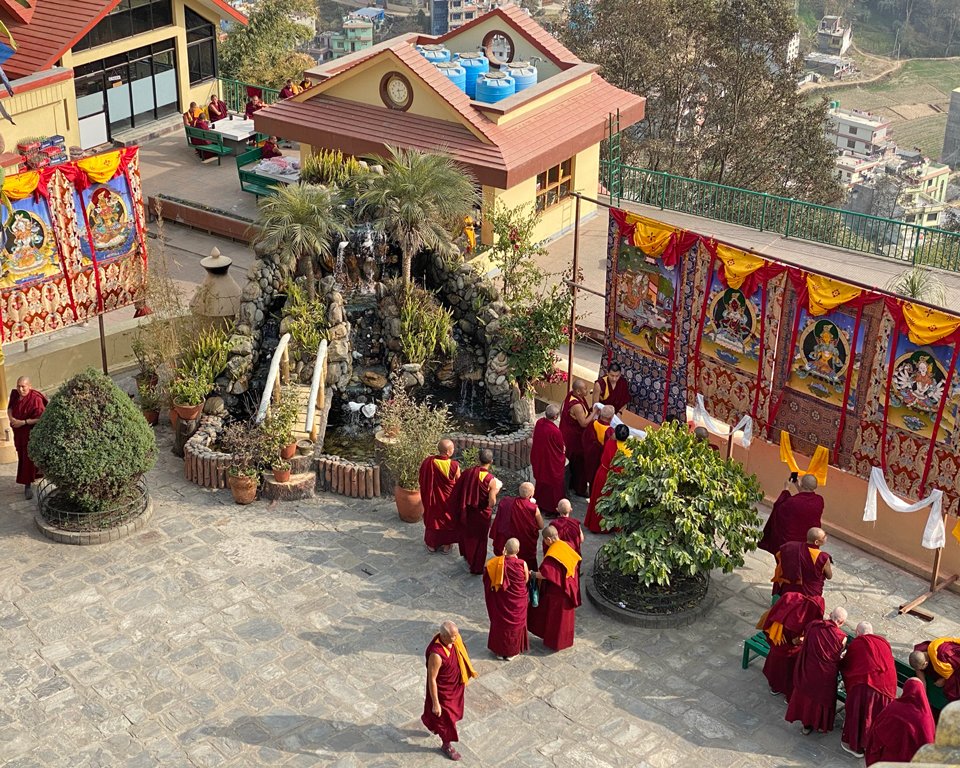
Lama Zopa Rinpoche with Khadro-la, Khen Rinpoche Geshe Chonyi, Kopan Lama Gyupas, and Kopan nuns, during consecration of the large appliqué 21 Taras and 8 Taras That Save from Fear thangkas outside Kopan Monastery’s main gompa, Nepal, January 2021. Photo by Ven. Roger Kunsang.
In the following Essential Extract video, from a teaching Lama Zopa Rinpoche gave in December 2019 at Kopan Monastery, Rinpoche explains the wheel of life drawing and reminds us that death can happen at any time. In the drawing you can see that the whole wheel is in between fangs. During our whole life we are between the fangs of Yama. And they can close any time. Rinpoche recalls a couple of events where people have died suddenly and unexpectedly. He strongly encourages us to meditate on death and impermanence. Otherwise you live your live with the concept of permanence, thinking “I will live long,” while wasting time. When you lie in bed, think, “Now I am lying here in my bed, but tomorrow I can already be on the pile of firewood in the cremation ground.” When you think this, attachment and anger have no reason to exist, and the mind is at peace.
Watch the sixteen-minute video “Our Whole Life We Are in between the Fangs of Yama”:
https://youtu.be/8HvK38Cm0HE
Transcript: So, I mentioned that the dongka, this is fangs, like you are in the mouth of Yama, impermanence, nature of impermanence, under impermanence. So holding like this, but anytime can be like this, mouth can close. So anytime death can happen. You never know, never you know. By next time this year, you are somewhere else—you never know—hell or deva realm, you never know where, by this time next year, by this time tomorrow. We can’t say—can close the mouth, you are inside now, between the fangs, but it can close anytime. So that is a very good meditation—it can close anytime. (Rinpoche closes his fingers.) It can close anytime, so death can happen anytime. You never know.
Even recently, I think in America or somewhere, it might be in the house, [someone] just suddenly died, who, I forgot. (Pause) Pende’s mother. Father and mother [were] talking in the house. They were talking to each other, and father did like this (Rinpoche turns his head), during that time mother, dead. They were just talking, the father and mother. Father went this way, then mother dead. So it always happens that.
One student here, she wanted to become a nun so much, unbelievable, so much. Khadro-la would see, of course. She is young, I think didn’t inspire her to become nun. Of course, Khadro-la can see past, present, and future. She [the student] died here in the toilet. She died here in the bathroom. I forgot her name. I have a big buddha in my room, I told them to make for her purification, good rebirth. I was thinking that her father to keep the buddha in the house, but the father didn’t want, so I have it in my room. … (Rinpoche offers more examples, see complete transcript.)
Like that anytime it can happen. I think that is the most important meditation, that is my, well, I haven’t started Vajrasattva, but my last advice is that. To remember, to always remember mindfulness, to always remember impermanence-death, that is my last very important advice, very important advice. I think that was also said by the Buddha, I forget now, to his disciples. Oh, that.
Kadampa geshe Sharawa said, “Even you have one hundred qualities, but you are under one mistake.” (Tibetan) So many, so many degrees from university, all this, all that, so many, like that, wow—but then even Dharma, even Dharma, “Oh, I know this, I know Madhyamaka, I know Pramanavartika, I did this retreat, that retreat, bah, bah, bah, bah.” But if you haven’t thought of impermanence-death, then there is the concept of permanence, so your life is under the control of hallucination. So “even if you have a hundred qualities but you are under one mistake,” so learned in Dharma texts, so many things, but you never thought of impermanence-death, yourself, or yourself, so then always you live with a concept of permanence, “I will live very long, I will live long,” always the concept of permanence. Then your actions of body, speech, and mind don’t become Dharma. You are very learned in Dharma, yes, unbelievable, but you never think of impermanence, your life is impermanence-death, you never think, so “I’m going to live long,” then your actions of body, speech, and mind don’t become Dharma. So here, even you are expert in Dharma but you waste your life. You understand? So like that. Did that retreat, this retreat, bah, bah, bah, but never, your own life impermanence-death, you didn’t think, so always wrong concept of permanence.
That is what Kadampa geshe Sharawa said. Even living in the monastery, doing extensive study, understanding and can explain, but never thought of impermanence-death, so your actions, with the concept of permanence then your actions didn’t become Dharma. Then death happens, then you know you cheated yourself. That is what you come to know, totally. There are more words, but… As I said, as I told before, same thing, even you are not learned in Dharma, nothing, but a lot of degrees, a lot of education in science, this and that, so many things, but never thought your life is impermanent, then suddenly—but you always live in concept of permanence—then suddenly when death happens so regret, so upset, so regret, bah, bah, bah, because you didn’t expect it, bah, bah, bah.
If you normally meditate, or you normally think, mindful in your life of impermanence-death, if you practice mindfulness every day remember, the awareness in that, even when death comes suddenly, you are not surprised. You are not worried because you did preparation. You did preparation because of mindfulness of that, so you did already preparation. So future life, to achieve happiness, body of happy transmigratory being, liberation from samsara, then enlightenment, thinking of impermanence-death, so then you have no worry when time of death comes, the actual time of death comes. Even for business people it is easier, normally you think so therefore it is easier. But normally you don’t think, so then it is incredible fear, bah, bah, bah, can be anger, like the Japanese boy, sssssh, can be incredible fear. Then of course, then, next life reincarnation, bah, bah, bah, good rebirth, higher rebirth, negative karma, lower rebirth, sssssh, there is another one.
So here it says, it is a good body, the body is here now, body is in your bed, body is here, but by this time tomorrow the body can be on the firewood, burned, skull coming out. You see the skull. (Rinpoche snaps his fingers.) Just anytime this can happen. (Rinpoche snaps his fingers.) It is so good, so good even meditating that you are dying, now you are dying. The whole thing, what is going to happen, going to the cemetery, the body by this time tomorrow, cemetery and fire, next year or next month, next week, tomorrow, the body could be there. That is so good, good meditation, so good meditation, that, to meditate, to think that. It is the reality. (Rinpoche snaps his fingers multiple times.) Then attachment to this and that, anger to this, bah, bah, bah, then you have no, there is no purpose to get angry and to be attached. This and that, all the problems, there is no reason to arise anger and attachment. The mind has great peace, free from attachment, free from anger.
Watch more videos from Lama Zopa Rinpoche’s teaching from the 2019 Kopan Course, the annual month-long lamrim course at Kopan Monastery in Nepal:
https://fpmt.org/media/streaming/teachings-of-lama-zopa-rinpoche/kopan-2019/
Find more Lama Zopa Rinpoche Essential Extracts videos:
https://fpmt.org/media/streaming/essential-extracts/
During February 2021, Rinpoche is taking a break from offering his video series Teachings on Thought Transformation during the Time of COVID-19. You find links to the ninety published videos in this series as well as transcripts, MP3s, additional practice advice, and more:
https://fpmt.org/fpmt/announcements/resources-for-coronavirus-pandemic/advice-from-lama-zopa-rinpoche-for-coronavirus/
Lama Zopa Rinpoche is the spiritual director of the Foundation for the Preservation of Mahayana Tradition (FPMT), a Tibetan Buddhist organization dedicated to the transmission of the Mahayana Buddhist tradition and values worldwide through teaching, meditation and community service.
- Tagged: advice from lama zopa rinpoche, essential extract, essential extract thought transformation teachings, impermanence and death, video
29
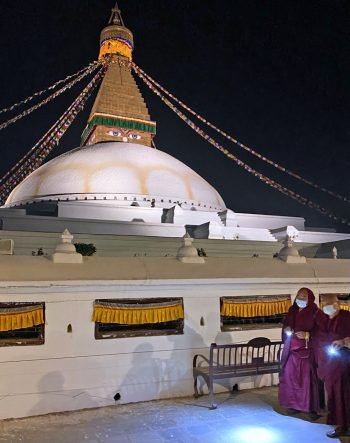
Lama Zopa Rinpoche circumambulating Boudha Stupa late at night, Nepal, January 2021. Photo by Ven. Roger Kunsang.
Patience: A Guide to Shantideva’s Sixth Chapter is a recent book of Lama Zopa Rinpoche’s teachings on the perfection of patience, a topic Rinpoche has taught on extensively. In this book, Rinpoche gives commentary on the verses on patience in Shantideva’s A Guide to the Bodhisattva’s Way of Life. Here’s an excerpt from the chapter “How to Accept Suffering”:
Shantideva next explained that whatever we do will become easier the more we practice it. This is very important advice. Whether something is easy or difficult depends on how acquainted we are with it. It all depends on training. Say we have been living with bugs for a long time: fleas, bedbugs, and so forth. This becomes normal for us. Fleas in our clothes, lice in our hair—they don’t bother us at all after a while. On the other hand, if we have never come across bugs before, if we are used to sleeping in a clean, soft bed and living a very luxurious lifestyle, to encounter bugs for the first time is a great shock. While there are fleas in our house we can’t do anything. We want them killed or we want to buy a new house!
Training the mind in patience can be done for worldly reasons or for the Dharma. I mentioned the people in India who cut and burn their bodies and fast for many days—something we cannot do. They can do this because they have trained their minds to accept that suffering, mistakenly thinking it is worthwhile. It all depends on how the mind—the colorless, shapeless, immaterial mind—interprets things. Something we find impossible to do can be done by somebody else easily. For a person who seeks worldly pleasure, practicing the Dharma is extremely difficult because their mind sees it as difficult. On the other hand, they will persevere for what they dearly want—possessions, reputation, and so forth—no matter how difficult, willingly undergoing hardships and danger.
For a Dharma practitioner it is completely the opposite. All the hard work needed to gain possessions, reputation, and so forth seems utterly pointless, but they willingly accept suffering to obtain the happiness of future lives, liberation from samsara, and enlightenment. Whereas the smallest samsaric thing is unbearable, they are happy to do the most difficult Dharma work.
Shantideva said we should not be impatient with things such as heat, cold, insect bites, and so forth, because if we are, then we will become increasingly intolerant of them. Conversely, we need to slowly build up our acceptance of small sufferings so we can start to accept greater ones.
Things that irritate us now, such as bad weather, can be the beginning of our training, learning to accept them for the sake of other sentient beings because we see the importance of developing patience on our road to enlightenment. Gradually, once we train our mind in these small sufferings, we can learn to become like the Buddha when he was a bodhisattva and give our body to a starving tiger.
Therefore it is greatly worthwhile to train the mind in patience in this way. If we live in a place that is full of snakes, mosquitoes, fleas, and bedbugs, it is like living in a palace full of jewels.
Excerpted from Patience: A Guide to Shantideva’s Sixth Chapter by Lama Zopa Rinpoche, edited by Gordon McDougall, published by Wisdom Publications:
https://shop.fpmt.org/Patience–A-Guide-to-Shantidevas-Sixth-Chapter-eBook_p_3366.html
Watch the video series “Lama Zopa Rinpoche’s Teachings on Thought Transformation during the Time of COVID-19” and find links to videos in translation, transcripts, MP3s, additional practice advice, and more:
https://fpmt.org/fpmt/announcements/resources-for-coronavirus-pandemic/advice-from-lama-zopa-rinpoche-for-coronavirus/
Lama Zopa Rinpoche is the spiritual director of the Foundation for the Preservation of Mahayana Tradition (FPMT), a Tibetan Buddhist organization dedicated to the transmission of the Mahayana Buddhist tradition and values worldwide through teaching, meditation and community service.
21
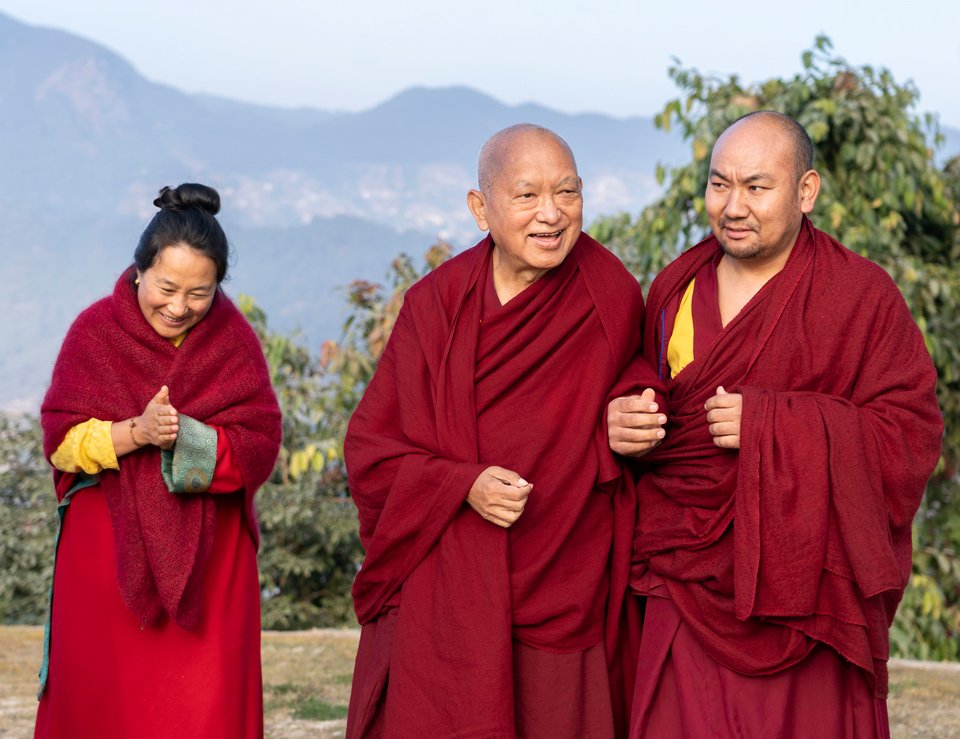
Khadro-la, Lama Zopa Rinpoche, and Ven. Thubten Tendar, Kopan Monastery, December 2020. Photo by Ven. Lobsang Sherab.
Patience: A Guide to Shantideva’s Sixth Chapter is a new book of Lama Zopa Rinpoche’s teachings on the perfection of patience, a topic Rinpoche has taught on extensively. (Perhaps this is not surprising since Rinpoche’s name “Zopa” means “patience.”) In this book, Rinpoche gives commentary on the verses on patience from Shantideva’s A Guide to the Bodhisattva’s Way of Life. Here’s an excerpt from the chapter “Overcoming the Wish to Retaliate” where Rinpoche discusses the conventional reason anger is inappropriate:
Ultimately, the enemy who gives harm and the harm itself are both empty. Neither exists inherently in any way. Because we are unable to see it like this, we should train to see things as like illusions, like dreams—maybe like hallucinations that happen when we take LSD! Because everything is dependent on other factors and nothing governs itself, these illusion-like phenomena are nothing to get angry about. It is like in our dreams there might be an enemy, but when we awaken we realize there is no enemy there, existing by its own nature.
The enemy is like a dream enemy, but that does not mean they are actually a dream, that is, nonexistent. When we are meditating on emptiness, we must be so skillful not to fall into nihilism. In his Four Hundred Stanzas, Aryadeva said that believing that nothing exists—including the I and karma—and hence falling into nihilism creates karma heavier than having killed a hundred million people.
If the emptiness of the I meant there were no I at all, either truly existing or merely labeled, then nothing would exist. No suffering would exist; no pleasure would exist. There would be no need to move the body, no need to breathe. Everything would be completely pointless. Everything we do is to attain happiness and stop suffering, but if there were no I at all, none of our actions would have any effect. With no I, why have expensive treatments in hospital to cure the I that doesn’t exist?
Many mistakes arise when we mistakenly think that the I doesn’t exist at all. We meditate to try to attain a peaceful, happy mind, but this I cannot receive any peace because it doesn’t exist. There is no karma, no cause, and no effect. There is no point to anything and no reason to refrain from creating negative actions.
To think that because there is no I, no enemy, no phenomenon, and therefore nothing matters, we deny karma. That is a completely dark mind; it is very dangerous. Emptiness is not nothingness; meditating on emptiness is not watching nothing, like sitting in a helicopter looking at blank sky.
Nothing exists ultimately, but because everything is a dependent arising, everything exists conventionally, existing in dependence on causes and conditions. The enemy, the anger they have, the harm they give us, all arise due to causes and conditions. The suffering we feel from that person’s anger has arisen due to karma, the negative actions we have done in the past, therefore we should not become angry in return.
For instance, it might seem that being criticized is a cause of anger, but if it that were so, then anybody who ever received criticism would have to get angry. That is not so. Somebody could criticize a buddha or a bodhisattva and no anger would arise at all. Even many ordinary goodhearted people will not react to criticism and other harmful actions.
A higher bodhisattva, who has totally renounced the self and only cherishes others, has still to remove the subtle imprints to knowledge, but all the grosser disturbing-thought imprints have been destroyed, so it is impossible to become angry even if somebody tried to harm them. Anger is only a condition; it is not an inherent cause. And because the cause is our own delusion, there is no reason to be angry at the person who has harmed us.
Excerpted from Patience: A Guide to Shantideva’s Sixth Chapter by Lama Zopa Rinpoche, edited by Gordon McDougall, published by Wisdom Publications (WisdomExperience.org).
Watch the video series “Lama Zopa Rinpoche’s Teachings on Thought Transformation during the Time of COVID-19” and find links to videos in translation, transcripts, MP3s, additional practice advice, and more:
https://fpmt.org/fpmt/announcements/resources-for-coronavirus-pandemic/advice-from-lama-zopa-rinpoche-for-coronavirus/
Lama Zopa Rinpoche is the spiritual director of the Foundation for the Preservation of Mahayana Tradition (FPMT), a Tibetan Buddhist organization dedicated to the transmission of the Mahayana Buddhist tradition and values worldwide through teaching, meditation and community service.
- Home
- News/Media
- Study & Practice
- About FPMT Education Services
- Latest News
- Programs
- New to Buddhism?
- Buddhist Mind Science: Activating Your Potential
- Heart Advice for Death and Dying
- Discovering Buddhism
- Living in the Path
- Exploring Buddhism
- FPMT Basic Program
- FPMT Masters Program
- FPMT In-Depth Meditation Training
- Maitripa College
- Lotsawa Rinchen Zangpo Translator Program
- Universal Education for Compassion & Wisdom
- Online Learning Center
- Prayers & Practice Materials
- Overview of Prayers & Practices
- Full Catalogue of Prayers & Practice Materials
- Explore Popular Topics
- Benefiting Animals
- Chenrezig Resources
- Death & Dying Resources
- Lama Chopa (Guru Puja)
- Lama Zopa Rinpoche: Compendium of Precious Instructions
- Lama Zopa Rinpoche: Life Practice Advice
- Lama Zopa Rinpoche Practice Series
- Lamrim Resources
- Mantras
- Prayer Book Updates
- Purification Practices
- Sutras
- Thought Transformation (Lojong)
- Audio Materials
- Dharma Dates – Tibetan Calendar
- Translation Services
- Publishing Services
- Teachings and Advice
- Find Teachings and Advice
- Lama Zopa Rinpoche Advice Page
- Lama Zopa Rinpoche: Compendium of Precious Instructions
- Lama Zopa Rinpoche Video Teachings
- ༧སྐྱབས་རྗེ་བཟོད་པ་རིན་པོ་ཆེ་མཆོག་ནས་སྩལ་བའི་བཀའ་སློབ་བརྙན་འཕྲིན།
- Podcasts
- Lama Yeshe Wisdom Archive
- Buddhism FAQ
- Dharma for Young People
- Resources on Holy Objects
- Ways to Offer Support
- Centers
- Affiliates Area
- Teachers
- Projects
- Charitable Projects
- Make a Donation
- Applying for Grants
- News about Projects
- Other Projects within FPMT
- Support International Office
- Projects Photo Galleries
- Give Where Most Needed
- FPMT
- Shop
Translate*
*powered by Google TranslateTranslation of pages on fpmt.org is performed by Google Translate, a third party service which FPMT has no control over. The service provides automated computer translations that are only an approximation of the websites' original content. The translations should not be considered exact and only used as a rough guide.Our desires are not limited to the things we can see, hear, smell, taste, and touch. Our mind runs after ideas as greedily as our tongue hungers for tastes.







